Spring 2017
Greetings colleagues. A brief update for the week of June 12,
I hope everyone’s summer is off to a good start. Of course, things continue to occur every day on campus and this email is an attempt to keep people connected to those campus events. First, a high level update on the budget:
As I imagine everyone knows, Governor Martinez recently approved the budget for higher education. HU (and other public institutions) will experience a budget reduction of 1%. For HU, that means a reduction of $284,600. Our unavoidable costs for 2017-2018 (e.g., escalators on software contracts, faculty promotions, etc.) total $325,000. A few weeks ago, the Board of Regents approved a tuition increase of 7.5%, so now the only unknown variable is our enrollment. That has been a challenge this year. The double challenge of the cancellation of all higher ed funding for a bit (driving some students away from New Mexico schools generally) added to the fact that we must inform all students we are trying to recruit that we are accredited, but on probation, makes for a tough environment. We’ll have to see where we land on enrollment. For every 1% increase in enrollment (over the 2016-2017 academic year), we’ll yield approximately $176,000. Conversely, every 1% decrease in enrollment will reduce our budget (from the 2016-2017 academic year) by that same figure. This is where things stand in relation to the budget.
I’ve previously sent out a summary of the last Board of Regent’s meeting. Many actions were taken including the selection of an architect for the Rodgers renovation, selection of a vendor for the new turf, and most critically, approval of our 2017-2018 budget. The Board also approved the emerita status of Dr. Mary Shaw and Dr. Jean Hill.
Several important searches are underway or will be soon underway. Buddy Rivera has served as our Interim Director of Institutional Research after the retirement of Dr. Jean Hill. Buddy has done well in that job and we should all thank him. After Jean’s departure, I elected to not immediately conduct a national search for the IR job. Given our issues with the HLC, we needed someone in there immediately and ideally, I wanted to allow our new Provost the opportunity to make the permanent selection. The IR job is a direct report to the Provost. That search is now underway. We have also had an interim appointment in the Dean of Students role. After Dr. Trujillo resigned from HU, I asked Dr. Kim Blea to serve in that job. Once again, that job is not one that can go unfilled even one day plus, I wanted to get the new Campus Life Initiative off to the best possible start and not wait until we had concluded a national search to get that going. That initiative is off to a good start and now, as promised, we’ll commence a national search for that important position. The Dean of Students is a direct report to me. I will make certain that everyone—even those not on campus over the summer—has an opportunity to weigh-in on these searches. All input will be carefully considered. The search committees will make recommendation to Provost Gonzales (in the case of the IR position) and to me (in the case of the Dean of Students) and Roxanne and I will make the final decisions. I hope these searches are concluded by the end of July. Several other important searches are also underway (e.g., Director of Financial Aid) or will soon be concluded. As is always the case this time of the year, there is also some movement within the faculty and staff. So many of the colleagues leaving us—either due to retirement or moving to another job in another location—have been and continue to be strong assets at HU and will be powerfully missed. In so many cases, our loss is some other school’s gain. But, we are all in the human development business—if we are in any “business” at all—and people change and grow over time and in some cases, desire new opportunities and challenges. Sometimes people just want a change. In the case of those good colleagues, I thank them for their service to HU, respect their many efforts to perform at high levels, which made them attractive to other institutions and highly competitive to win new jobs, and wish them nothing but the best in their new adventures.
We continue to perform well in the advancement domain. We began a major restructure of that unit during my first year here and those efforts are now bearing fruit. In the last several months, we have won $500,000 to replace our turf, another $100,000 for a major renovation of Stu Clark, and $350,000 to name the Trolley Barn after two wonderful HU alums. There will more details on these donations coming out soon. We are also close on a donation for a new video scoreboard and have recently brought in several four and five figure gifts for scholarships. In total, we’ve accrued more than $1mil over the last couple months and perhaps more on the way. We also continue to host numerous alumni events around the state. I say, well done to those in that unit. Very good performance!
Dr. Edward Martinez, Dr. Kim Blea, Dr. Roxanne Gonzales, Dr. Brandon Kempner, Mr. Max Baca, Mr. Sean Weaver, and I recently met with Secretary Damron and others to provide an update on our activities relative to the HLC. My colleagues, believe me when I write that many others around the state are interested in our work to address the HLC concerns. It was a good meeting and everyone there expressed strong support for HU. Accreditation is rapidly changing and I anticipate that more changes are on the way. Partially due to those changes and concerns about others on the way, accreditors are much more serious about things these days, which I think is a good thing. If we will do it, let’s take it seriously and do it well and…let’s do it in such a way that has real potential for meaningful improvements. I think that is happening now. In the last round of accreditation visits by regional accrediting organization in the United States, 15% of all schools were either denied accreditation, issued a warning, or placed on probation. That’s 68 institutions…in one year. That number is in stark contrast to previous years when essentially no institution received any type of sanction. But, that is certainly not true today. Here’s an interesting article if you’d care to peruse: http://www.chronicle.com/article/Don-t-Tear-Down/240292?cid=at&utm_source=at&utm_medium=en&elqTrackId=315224186e794e0c86c978fa4023f78e&elq=1d53c84ec7fe4f5a81662f9083f4c471&elqaid=14276&elqat=1&elqCampaignId=5995.
As other important campus developments occur over the summer, I will do my best to inform everyone.
Sam Minner, Ph.D.
President, NMHU
Top
Greetings colleagues. A brief update for the week of May 8-12;
I am nearing the end of my second year on the HU campus. It is has been a real honor to be here, to get to know new colleagues, and to learn some lessons about HU’s history, traditions, and institutional culture. Of course, given the job I am in I have also quickly been immersed in the immediate challenges facing the institution. I’ve also been able to take some time to think seriously about our longer term future. I won’t deny that it has felt like a bit of a whirlwind, but it has also been very enjoyable, gratifying, and on most days…a lot of fun. I get tired of hearing and reading things from college administrators (and others who work in the academy) who go on and on about how difficult things are, the intractable problems we all face each day, and how the best things about the academy are behind us. I totally deny all of that. What I don’t hear enough about is how much fun it is to do the work we do. I mean, really…to get up every day and help students achieve their dreams, to make new knowledge in the disciplines we love, and to serve humankind by applying what we know to real problems…that’s a pretty good gig. Ask around.
I certainly do not deny that we face many challenges here at HU. In many ways, I think they are part of a much grander suite of challenges everyone in the sector faces. For example, raising tuition (or not) is not the problem at all. The problem, as I see it, is the very different view we have as a society about the beneficiaries of a college education and who should pay for it. Decades ago, a college educated citizenry was deemed so important in a free nation that everything that possibly could be done to make it very low cost was done. Sending students to college at very low cost was viewed as a societal benefit and thought necessary to build and sustain a strong democracy. Sure, students benefited by gaining access to better opportunities and the ability to engage the world in a thoughtful and enlightened way, but…that was really not the only reason for making certain attendance was low cost. Society was the main beneficiary. I love the quote from Thomas Jefferson and by “tax” he is referring to government support of education, “The tax which will be paid for the purpose of education is not more than the thousandth part of what will be paid to kings, priests and nobles who will rise up among us if we leave the people in ignorance.” His point is no less true today. Do not educate citizens at high levels…even in 2017… and see what happens. Today, the ideas about college seem very different. The thinking seems to be…if you can figure out a way to pay for a college education (which will mainly benefit you), then go for it. If you cannot figure that out, well…good luck to you. Arguments asserting that one is supportive of or against tuition increases are just too easy. The real “problem” here is not about tuition at all. In 2017 America, do we want citizens to be able to attend college at low cost…or not? If so, we simply must work together to find a way to do this and blaming the state or federal government, boards, administrators, the faculty, lenders or any other single group gets us nowhere.
Of course, whatever the real problems or their root causes may be, we still must grapple with them and do the best we can to solve them. Even in this difficult environment, I remain pretty optimistic that we can do so.
And I look forward to working with the Board, my faculty and staff colleagues, and the many friends of HU to do just that. I have tried to be a good servant-leader to HU and will continue to try hard. Agree or disagree with my decisions as you may, but I can assure you that all of them were made with the best interests of the institution at heart. Nothing more. I am no longer building my CV or angling for a different or better job. I do not play political games or compromise the best interests of HU in order to curry favor. For me, Highlands comes first and everything…and I mean everything else …comes later. I will also continue to behave in ways consistent with that standard.
My weekly messages will be on hiatus until the beginning of the new fall term, However, I might send out a few messages if I think people might be interested in them. I hope everyone has or takes the time for a little well-deserved R&R this summer. That can be hard to do, but a balanced life is a very desirable goal and one we should aspire to achieve.
Thank you, my colleagues, for the opportunity you have given me and let us recommit to the important ideals of our work—to teach our students at high levels, to make new knowledge in the disciplines we love, and to serve humankind and make the world a better, more just, and more beautiful place.
All the best,
Sam
Top
Greetings colleagues. A brief update for the week of May 1-5:
- I have previously informed the campus that the new Provost/VPAA will be leading and managing the HU commencements at Rio Rancho and on the home campus. This will allow me (and Joan) to attend our son’s graduation from law school at the University of Missouri. I made every possible attempt to find a way to attend our graduation and still get back in time for his ceremony, but alas, plane nor train nor any other method of conveyance worked. I appreciate the Board’s support of my absence as well as the campus community’s indulgence. The supportive comments I’ve heard around campus and the community say much about everyone’s commitment to family. I think—never sure—that this will be the last graduation ceremony for any of our kids, so truly a red letter day for the Minner household. But, I do regret missing the ceremonies here and seeing our proud graduates walk across that stage and I thank Provost Gonzales for taking on this important duty.
- An update on the state budget—now, the Governor asserts that she has a plan to fund higher education. Go to: https://www.abqjournal.com/997946/gov-martinez-says-she-has-higher-education-funding-plan.html?utm_source=newsletter&utm_medium=email&utm_campaign=breaking-news-alert&utm_source=Albuquerque+Journal+Newsletters&utm_campaign=b54bc28414-EMAIL_CAMPAIGN_2017_05_03&utm_medium=email&utm_term=0_2dcf4c82cd-b54bc28414-108029073. However, some legislators do not feel the plan is viable and a few have already publicly come out against it. Bottom line—-effective July 1 there is still no funding for New Mexico public higher education.
- As many of you know, we recently hired Mr. Mariano Ulibarri to serve as our liaison to Los Alamos Labs. One of his major duties pertains to outreach to local and regional K-12 schools. We were just informed that a grant we proposed to LANL to expand our outreach efforts has been approved. Among other things, we’ll purchase a trailer with these dollars and fill it with various technology, demonstrations, and experiments to encourage interest in science and technology and ideally, draw additional students to HU. Well done to Mariano, Ms. Elizabeth Ratzlaff, and everyone who made this happen.
- Strategic Enrollment Management in collaboration with other partners continue to produce new recruiting materials. Here’s a recruiting brochure we recently produced in Spanish: https://spark.adobe.com/page/HngNz . Here’s an emag we’re doing now: https://spark.adobe.com/page/XFBLbXIgwzqcA/ . Another emag: https://spark.adobe.com/page/uS4LFDQpYzgvr and a Viewbook: www.nmhu.edu/welcome . Well done to all doing this important work.
- For the past two years CESDP has been in partnership with the NMPED to revise the CESDP Family Partnerships Toolkit (2006). That work is now completed and The Family, School, and Community Partnerships Framework (Toolkit) is done. This toolkit provides a wealth of resources and information for educators, faculty members, and New Mexico families. The resources are provided in both English and Spanish, they are aligned to the National PTA Standards, and it provides new research and new “Tools for Schools”. The NMPED will roll the Toolkit out this fall and will strongly encourage districts to implement this Framework to engage families to satisfy Title I, Title III, Title VII, IDEA, ESSA, etc. regulations. The Website for this resource: www.nmengaged.com. Congratulations to our good colleagues at CESDP.
- Last Saturday, we held another Campus Life event in Wilson. The Common Kings and JBoog performed for our students. A pretty dramatic late-season snowstorm kept the crowd down, but those who attended had a very good time. A photo of some of our students and staff along with the Common Kings:

There was also a wonderful Climate Awareness Summit on campus last Saturday. Organized at a grassroots level by Dr. Linda LaGrange and other faculty and staff members, it was a wonderful day of presentations, discussions, and activism in regard to climate change and other changes in our environment. Again, an early spring snowstorm perhaps kept a few people away, but those who attended benefited from the discussion, no doubt. A photo from that meeting: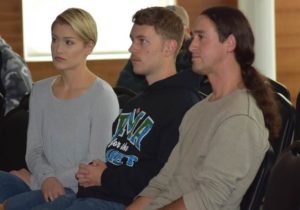
- Tuesday was a busy one including a temporary displacement for several people due to some Longmire filming and a very nice donor sponsored dinner for our women’s track and field team. I should also note that HU has already been paid for the use of our facilities during the Longmire filming. The actor Robert Taylor (Longmire) and a shot from the track dinner:
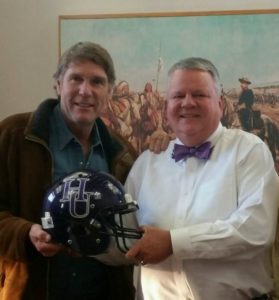
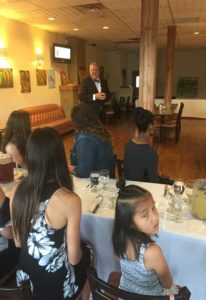
- Wednesday was also busy with a nice reception for the HU Reads project and the Student Senate Gala later that evening. I do think it is important that the HU faculty and staff model lifelong and recreational reading as an important habit. Adult reading has been on the decline for some time in America and in my view, that is not a good thing. The HU Student Senate is an important body on the campus and has the potential to work with the faculty, staff, administration and the board to improve our outcomes. Of course, it also has the potential to help senators sharpen their leadership skills and knowledge. Many well-known leaders honed their leadership skills as the Presidents of Student Senates. A photo of Ms. Kim Blea swearing in the new Student Senate President, Ms. Natasha Lujan.
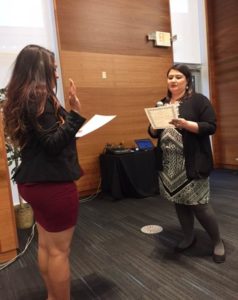
- Things are coming together for the National Small College Rugby Organization (NSCRO) championship in Philadelphia. As you know, HU will be competing in that tournament. It will be broadcast on NBC Sports. It is estimated that about 30,000 people will see the tournament in person and many more than that on television. HU will compete against teams (and believe me, most of them have much deeper pockets than HU) including St. Mary’s College (Maryland), Colby College, Duke University, and others.

- There was a very nice flag raising ceremony on Thursday. Our international students raised the flags from their home nations as their national anthems played in the background. Many thanks to Ms. Tina Clayton for organizing this event. We now have students from more countries than we have flagpoles, so we’ll have to switch some flags so every country’s flag is flying at least some of the time. Also on Thursday, Ms. Tina Clayton, Dr. Edward Martinez and I met with a representative from World Learning, an organization that we are working with this year. We have five students on campus from World Learning. Those students come to us and study one or two terms and then return to their home countries. A few photos from the ceremony:


- This Week in Accreditation: At the Friday (4/28) Board of Regents, the Board took several actions that will assist in removing our probationary status. The Board approved an updated Board of Regents manual that includes the new mission and updated guidelines from the AGB, the Association of Governing Board of Universities and Colleges. Both of these directly address the probationary concerns surrounding the Board of Regents, including evidence of utilizing best Board of Regent practices. The Board also endorsed the Capital Assurance Procedures, prepared by Sylvia Baca and also endorsed by the Faculty Senate, Executive Management Team, and Staff Senate. These procedures apply to building projects over a $1,000,000, and are designed to keep those projects on time, on scope, and within or under budget. We’ve already applied these guidelines to the Trolley Barn; creating such procedures was an explicit requirement from the HLC. Finally, the Board took a close look at the various tuition and fee scenarios, including impact on students, which should provide evidence that the Board understand its fiscal duties; another area of concern from the HLC. Everyone wants tuition and fees as low as possible in order to maintain operation and services to students, but the HLC really does not weigh-in on tuition and fee rates. Virtually every other institution working with the HLC has higher tuition than HU. However, they do want evidence that boards formally approve tuition and fees and debate the potential impact of those fees on the financial position and health of the institution as well as the potential impact on students. In other words, they want boards to fulfill their fiduciary responsibility. Clearly, we can prove that both of these objectives were achieved at the last meeting.
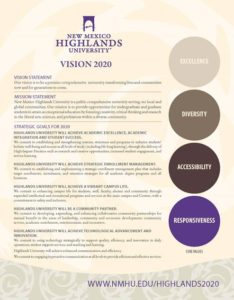
Sam Minner,
President
Greetings colleagues. A brief update for the week of April 24-28:
- As of today, there is still no date for the Special Session and New Mexico higher education remains zeroed out altogether effective July 1. Several legislators have filed a lawsuit against the Governor (go to: https://www.abqjournal.com/992522/nm-supreme-court-to-hear-arguments-in-budget-veto-dispute.html), some reports suggest that state revenues are doing well, relatively speaking (go to: https://www.abqjournal.com/992636/new-report-nm-taking-in-more-revenue-for-fy17-than-projected.html), and the letter from the Council of University Presidents (CUP) continues to be circulated and garner some attention both in-state and nationally (go to: https://www.abqjournal.com/988393/unintended-message-a-bad-one.html). I had a letter to the editor in last Sunday’s Optic. It is attached (above). There continues to be messaging from Santa Fe that there is no real chance that universities will receive zero funds effective the new fiscal year. That just can’t happen these days, right? Again, I reference the state of Illinois where 1,100 employees—staff, faculty members, and administrators— at Northeastern Illinois University were recently required to take five furlough days. The reason? A showdown between the state legislature and the governor. Thus far, no one in Illinois has blinked and…state universities have received little or no state funding. So, it can happen.
- The end of last week and last weekend were busy. On Friday, we held a special board meeting. A brief summary of the meeting appears below:
The Board of Regents held a special meeting April 21 with three major agenda items: a discussion on a tuition and fee adjustment, approving changes to the collective bargaining agreement and revising the university’s naming policy. While the latter of the three items was tabled, it did lead to an announcement I’m happy to share. As many of you know, the Highlands Foundation has been raising funds to replace the football field turf, which is seven years past its life expectancy. The cost to replace the turf is $500,000, and we had one donor commit to the entire amount: our chairman of the Board of Regents, Leveo Sanchez. Additionally, Regent Sanchez is committing another $100,000 to renovations of the Stu Clark building. We want the building to be a point of pride in our recruitment of student athletes who comprise about a quarter of our student population. Regent Sanchez is a true son of Highlands with a lifelong affiliation to our institution and certainly deserves our thanks for such a generous gift. I would also like to thank Athletic Director Bob Clifford and Vice President for Advancement Terri Law for their part in landing this gift and others. Max Baca presented various tuition scenarios and the board is expected to formally vote on tuition and fees during next week’s regular meeting. Let me be clear: I take our commitment to an accessible, transformative education seriously, and we know any increase of tuition and fees impact our students and their families. However, we are highly dependent on state funding and, as I’ve said many times before, when the state sneezes, we catch a cold. As Mr. Baca pointed out, we are facing both cuts and increased costs. We’ve had more than $7 million of new-money requests from which we’ve identified $1 million of priority requests. Thanks to Mr. Baca’s dedicated work, we haven’t seen the furloughs other institutions are experiencing. Most importantly, Highlands is making good strides forward in increased and predictive recruitment. We simply cannot stop this process. Even a 7.5% tuition increase (which may or may not be approved by the BoR), will still rank Highlands as the most affordable four-year institution in the state, the third most affordable in the southwest region, and the eighth most affordable out-of-state tuition in the U.S. Combine those figures with the fact Highlands graduates earn the second highest average salary in the state, we are an institution that delivers great value. Lastly, the Regents approved revisions in the Faculty Association Collective Bargaining Agreement. Let me say, I have a high degree of respect for unions and come from a strong union family. When I arrived at Highlands, I was pleased to find there was a faculty union. It provides a formal and professional way to positively interact with each other and make the institution better.
On Saturday, I welcomed a large group of new incoming freshmen and prospects to our campus. The meeting was very well organized, the food was great, and I heard many positive comments about the presentation. A photo as people are getting ready for the morning’s event: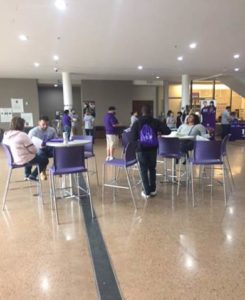
Later on Saturday, I attended a very nice tree planting event in Melody Park. A tree was planted in honor of Earth Day and in honor of one of our students. The mother of the student commented on how her daughter had grown in so many ways, like a young tree, on our campus and in our care. It was really moving. The mom and the new tree: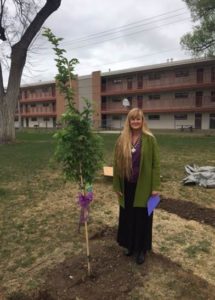
Even later that day, a group of HU student athletes volunteered to participate in the annual Main Street de Las Vegas Façade Squad. They painted a building in town and by looking at the photo (below), had a great time. Many thanks to Coach Mendoza and our wonderful Cowgirls soccer team for helping out. They are looking sharp in their HU/Nike warm-ups, no? Main Street de Las Vegas is one of the best things in our town and it is so great that so many HU students help out on Main Street projects. Well done to all.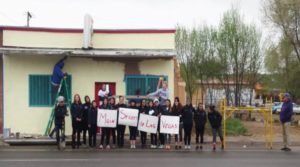
After some busy days, I needed a little R&R. Took a hike on the Gallinas Trail. My soon to be HU graduated and beloved niece Lily in what I thought was a dangerous yoga pose on the trail. But heh, when you’re young, nothing bad can happen, right?
- HU’s online program in special education has been named the third most affordable special education master’s program in the nation by the education publisher, SR Education Group. Yet another indicator of HU’s overall affordability. Well done.
- In addition to the major gifts noted above, we continue to bring in other gifts from various sources. For example. on Monday, HU received a very nice check from Enterprise Rent A Car (see photo below). This week we also received another commitment for a $5,000 gift. On Wednesday. Terri Law, Bob Clifford, and I were on the phone with another potential donor. Other fundraisers are planned in the near future and we continue to cultivate new donors. Well done to the team in Advancement. Also in that unit, we will soon begin serious training on our new fundraising CRM, Raiser’s Edge. More money is raised using that product that any other CRM in the nation . This will modernize our advancement efforts to a very significant degree and touches on our 5th and 6th Strategic Goals (e.g., “technological advancement” and “enhanced…efficiency”). I should also note that the funding for this product is coming from the Foundation; we are not using any HU resources for this at all. Ms. Corie Weaver will lead the effort to implement this product.
- Other activities I have been involved with this week or have been brought to my attention:
- Dick Greene, Jefferson Fellow at the National Academies of Science, Engineering, and Medicine and HU faculty member, is starting his Fellow duties with a big splash. Several major news outlets will soon be scheduling interviews with him including BBC World Service News, Time magazine, CBS morning news, and the French publication, Sciences et Avenir. I think the stories have also been picked by the Daily Mail and Men’s Fitness. I’ll pass on the specifics as they are set so interested people can tune in or read the interviews. Dick also recently presented at the meeting of the American Physiological Society in Chicago. His presentation focused on the advantages of walking in regard to blood flow and was done in collaboration with several HU undergraduate and graduate students and researchers from the New Mexico School of Medicine, the University of Colorado School of Medicine, and the University of Copenhagen School of Medicine.
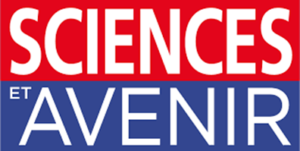
- HU is working with Luna CC to devise an agreement that will allow Luna to compete on our ball fields. This is a very nice demonstration of collaboration. Thanks to AD Clifford and everyone who is working on this. Could be a real win-win for everyone. I’ll let the campus know when this is finalized.
- Members of the HU executive team will soon be participating in a 360 degree review. This will be a “developmental review”—that is, designed for their own growth and development as leaders and not evaluative. I should note that this touches on one of my board goals. If you are listed as a respondent on one or more of these, I ask that you please participate. Responses will remain anonymous, but if you don’t want to participate, that’s your call. I have been involved in a number of 360’s and in many cases, they have been really helpful. Getting input from people you report to, your peers, and people who report to you and then triangulating that input can reveal some trends that are useful. I also like the fact that the input is anonymous. Some people tend to be a little more direct—sometimes even honest—under those circumstances. This time around, only a select group will participate, but I ask that we consider using this approach, or some modified version of the approach, in other developmental and or evaluative processes on our campus. For example, many campuses require external reviewers to examine tenure and promotion portfolios and provide input into the ultimate personnel decisions. I have found this very useful in the past. We are all part of a broader academic community and it is sometimes very helpful to receive objective input from individuals who do not know us and work with us every day. People who do not like or dislike us—just colleagues who make an objective assessment. We can maybe have that discussion later and I understand that this type of change would have to be negotiated. But, as I wrote, this particular 360 will only involve members of the executive team and a few others who meet with that team on a routine basis. I should note that in regard to this small latter group, their participation is totally voluntary.
- Longmire will once again use some of our spaces to film some scenes. I think they’ll shoot in the President’s Conference Room, Dr. Martinez’s office, and Dr. Linder’s office. We may once again ask inhabitants near these spaces to stay away from them during the filming. Many thanks to all who will be temporarily displaced during this process. Of course, HU will be compensated for this.
- Joan and I will once again travel to Philadelphia to see the Vatos defend their national title. My sister, who I am certain has never seen a rugby match in her life and probably never attended a college game of any kind in her life, will also be joining us. So, the Vatos will have a least three people cheering them on. A photo of the Vatos after their recent win at Tulane:
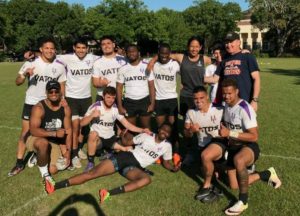
- The date has finally been set for the next “Big Ideas” reading group discussion. HU participants and our colleagues from Northern will meet on June 15 to discuss Austerity Blues by Michael Fabricant and Stephen Brier. I know that June 15 is hardly the ideal date, but we are working with colleagues at Northern and we need to try to find the best date for the most people. The June 15 date is what we hit on. Here’s a review—this first appeared in the Johns Hopkins Press:
Public higher education in the postwar era was a key economic and social driver in American life, making college available to millions of working men and women. Since the 1980s, however, government austerity policies and politics have severely reduced public investment in higher education, exacerbating inequality among poor and working-class students of color, as well as part-time faculty. In Austerity Blues, Michael Fabricant and Stephen Brier examine these devastating fiscal retrenchments nationally, focusing closely on New York and California, both of which were leaders in the historic expansion of public higher education in the postwar years and now are at the forefront of austerity measures. Fabricant and Brier describe the extraordinary growth of public higher education after 1945, thanks largely to state investment, the alternative intellectual and political traditions that defined the 1960s, and the social and economic forces that produced austerity policies and inequality beginning in the late 1970s and 1980s. A provocative indictment of the negative impact neoliberal policies have visited on the public university, especially the growth of class, racial, and gender inequalities, Austerity Blues also analyzes the many changes currently sweeping public higher education, including the growing use of educational technology, online learning, and privatization, while exploring how these developments hurt students and teachers. In its final section, the book offers examples of oppositional and emancipatory struggles and practices that can help reimagine public higher education in the future. The ways in which factors as diverse as online learning, privatization, and disinvestment cohere into a single powerful force driving deepening inequality is the central theme of the book. Incorporating the differing perspectives of students, faculty members, and administrators, the book reveals how public education has been redefined as a private benefit, often outsourced to for-profit vendors who “sell” education back to indebted undergraduates. Over the past twenty years, tuition and related student debt have climbed precipitously and degree completion rates have dropped. Not only has this new austerity threatened public universities’ ability to educate students, Fabricant and Brier argue, but it also threatens to undermine the very meaning and purpose of public higher education in offering poor and working-class students access to a quality education in a democracy. Synthesizing historical sources, social science research, and contemporary reportage, Austerity Blues will be of interest to readers concerned about rising inequality and the decline of public higher education.
I’ll be working with the new Faculty Senate President to select a book for the fall term. Though not really a “higher education” book per se, I’d recommend Hillbilly Elegy: A Memoir of a Family and Culture in Crisis by J.D. Vance. I read that book recently—a recommendation from my librarian daughter in Maine—and as I said the other day, Librarian’s Rule!—and it was very interesting and I think, explains a great deal about what we are experiencing in contemporary American society. I also understand that Ron Howard will be making a film of the book. At any rate, this is but one possibility. We’ll work together and make a good choice for the fall.
- We are very close to implementing a GED testing center on campus. This has involved many steps and approvals, but we are close. When everything is done, people from the region will be able to come to HU to take the exam. I understand that now they must drive to Santa Fe. Many thanks to Dr. Carol Linder and Mr. Benito Pacheco for making this happen.
- HU recently received a Heritage Award for the renovation of our beautiful Trolley Barn. Many thanks to Ms. Margaret McKinney for preparing the application leading to this award. Well done Margaret and to all who made this project a success. That does not happen by chance.
- On Thursday, I was able to attend presentations by the student recipients of the Seabury Award. One produced a very moving film, one designed an advertising campaign for a new business, and one used his personal life experience to design an d install some fabric on some pieces of furniture. Each presentation was simply outstanding. Really great. Hats off to those students and the faculty who assisted them to complete such wonderful projects.
- Later on Thursday, Joan and I attended the Santa Fe graduation celebration. It was very moving and a great evening overall. Many thanks to HU folks who attended, particularly Regents Turner and Vigil.
- We still need a few faculty and staff volunteers for the commencement ceremony. I know it is an incredibly busy time of the year, but please consider helping out to honor our students and their families on that special day. If you can help, please contact Ms. Juli Salmon at jesalmon@nmhu.edu.
- We have a board meeting this Friday so, once again, my weekly message is being sent a bit early. I’ll provide the campus with an update of this Friday’s meeting next week.

Sam Minner,
President
Greetings colleagues. A brief update for the week of April 17-21:
- I spent Monday and Tuesday at the Rocky Mountain Athletics Conference (RMAC) in Colorado Springs, CO. The presidents of all RMAC schools attend these meetings. I was joined by Athletic Director Bob Clifford, Mr. Max Baca, and Ms. Karin Gadberry. We had a long agenda including items related to PR and broadcast rights, changes in football practice requirements, soccer officiating, and other more routine matters. I love the Division II organizing metaphor—Life In The Balance—that recognizes that in Division II, we serve student-athletes and the ordering of those words is not by chance. Once again, the goals of athletics at HU—-(1) provide student athletes with a quality academic and athletic experience, (2) help all student athletes graduate on time and with the lowest possible debt, and (3) field competitive teams who win their fair share of games and championships. I should also note the very positive performance of our athletic program in two particular areas: our performance on random drug testing when the NCAA was here a few months ago (100% pass) and very positive comments from the RMAC about the professionalism, sportsmanship, and overall deportment of our teams over the last year. These things do not happen by chance. Well done to AD Clifford, our coaches, and our student-athletes.
- New Mexico higher education is recently getting some national attention—but not the kind anyone wants. Check this article from The Chronicle of Higher Education: http://www.chronicle.com/article/The-Next-Higher-Ed-Funding/239826.
- We were just informed that the NMHU Media Arts Trolley Barn has been officially certified as LEED Silver. To achieve that rating, you have to address several variables including (1) sustainable building sight (e.g., constructing a building to curtail erosion), (2) water efficiency, (3) energy consumption, (4) materials (using recycled materials), (5) indoor air quality, and (6) others. Well done to all who made this happen.

- The Presidents of the Student Senates across the state, including our own siting President, Mr. Julian Padilla, recently sent a letter to the Governor and state lawmakers expressing their deep concerns about the recent action to zero out all funding to higher education and the inability, thus far, of elected officials to come together to pass a budget. I thank them for doing so. Here’s the letter:
We, the presidents of the student government associations of the four-year higher education institutions in the State of New Mexico, are concerned about the Governor’s line-item veto of New Mexico Higher Education. We firmly believe that access to higher education is more important than ever in New Mexico. We need to be investing in bright and innovative minds to tackle our state’s challenges. We are disappointed in those elected to serve us, as they have allowed such a critical issue to be caught in the middle of partisan political crossfire. If the Governor truly cared about higher education in this state, she would not leave our higher education institutions and the thousands of students they serve in the dark about their anticipated budgets for the next year. We find it disappointing that politics are being put in front of the success of New Mexico students. We urge our Governor and legislators to come together during the special session to address higher education funding with students and the future of New Mexico at the forefront of the conversation. Protect our students from politics and ensure that we are given the resources we need to become the next generation of leaders in our state.
Kyle Biederwolf
ASUNM President
Matt Bose
ASNMSU President
Gabriel Montoya
NM TECH SGA President
Julian Padilla
ASNMHU President
Claudia Osuna Ochoa
ASWNMU President
Joshua Alvarez
ASENMU President
- A new report from the consulting firm Deloitte was just issued titled Pathways To The Presidency. I was a respondent in that study so I was interested in the findings. Among them:
- Many presidents these days do not come from a provost position. Many come from a dean position.
- Provosts tend to have a different skill set than presidents. Provosts focus on “inward and down” meaning they focus on academics inside the institution while presidents focus on “up and out” meaning they tend to spend time on relationships, boards, alumni, and donors. I don’t think anyone is suggesting this is necessarily good—it is just a picture of what is happening.
- Irrespective of the size of the institutions, presidents agreed that fund-raising was a major part of their job.
To see the complete report, go to: https://www.insidehighered.com/news/2017/04/19/report-finds-unsettled-pathways-college-presidency?utm_source=Inside+Higher+Ed&utm_campaign=791360b573-DNU20170419&utm_medium=email&utm_term=0_1fcbc04421-791360b573-198622925&mc_cid=791360b573&mc_eid=1b6e1fa6ce. Another report about university presidents will be coming out soon—this one from the American Council on Education (ACE). I was also a respondent in that one and will pass the results on once I receive them.
- Things continue to go well in the Advancement realm. VP Law and her team continue to cultivate several significant donors and we hope to make announcements about major gifts in the near future. Finalizing these major gifts is a complex endeavor involving donors (and often their families), members of our Foundation Board and the Board of Regents, attorneys, and others. It all takes time, but….I am very pleased with how that unit is now performing.
- Hope you can make it to the reggae concert in Wilson on April 29 . We are ready for JBoog and Common Kings. Are they ready for HU? Photos of the GRAMMY nominated artist JBoog and Common Kings.


- There will be a Board of Regents (BoR) meeting this Friday so I am sending my weekly message a bit early. I’ll provide an update from the BoR meeting next week.
- This Week in HLC Accreditation (from Dr. Kempner): On Monday (4/17), we held our mid-way forum, discussing the progress we’ve made and what we still need to accomplish before our HLC visit, which takes place on November 6th-8th, 2017. Please think about how you can contribute to our accreditation efforts as we enter this essential 6 month period for the future of Highlands.
 Sam Minner,President
Sam Minner,President
Greetings colleagues. A brief update for the week of April 10-14:
- I imagine everyone saw or heard about the Governor’s decision last Friday to zero out the budgets for the legislative branch and for higher education. This will happen on July 1. As of that date, HU and all other public institutions of higher education will receive nothing from state government. Things could change, of course, but that is the status of things now. Here’s one news article about this matter: http://www.lcsun-news.com/story/news/local/new-mexico/legislature/2017/04/07/martinez-vetoes-tax-hikes-funding-higher-education/100191342/.
- After many efforts to find a way to attend my son’s graduation from law school and still preside at our commencement, I simply cannot find a viable option. I have reflected on all this a great deal and have made the decision to attend his graduation, which means that our new Provost and VPAA, Roxanne Gonzales, will lead the commencement ceremony. I regret that I will not attend our ceremony and hope everyone understands my thinking on this. I regret my absence, but simply cannot find a way to do both. I did try.
- The weekend was a busy one. Joan and I spent some time with the family of the student tragically lost in an automobile accident the previous week. Our hearts break for the loss of a beloved HU family member. A large contingent of HU students, coaches, staff, administrators and others attended the funeral services on Monday. On Sunday, Ms. Kim Blea, Mr. Max Baca, and I appeared before the HU Student Senate to brief them on the current budget situation and answer questions. As promised, Mr. Baca also provided the Senate with an overview of where we stand on the Campus Life budget. We promised to do this when the Campus Life fee was approved. Joan and I also attended a very nice reception for a wonderful photographer sponsored by the Las Vegas Arts Council. Joan is on the board of that nonprofit.
- Our mighty Vatos have once more prevailed and will defend their national small college title in Philadelphia in June. Over the weekend, the Vatos played in the tournament in New Orleans and defeated several schools to advance to the championship. A photo of the Vatos after their national win last year:

- Also last weekend, a group of HU folks ran in one of several races in Albuquerque. Some ran a half-marathon, some ran a 10K , and some ran a 5K. A photo of Lauren Faith (English), Jessica Jaramillo (Director of Recruitment and Admissions), Eli Mohanna from ARMAS, and Professors Dulcinea Lara and Jessica Snow sporting some HU advertising before the races:

- Monday was a busy one including a visit with an LFC working group to discuss cost drivers in New Mexico higher education, a phone meeting with all CUP presidents to discuss the recent actions of Governor Martinez and our possible response to those actions, and a meet and greet with some prospective students from Mora. A very poor selfie of me and some of the Mora students:
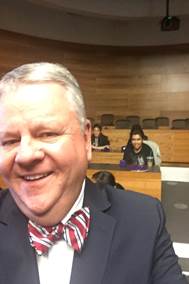
- On Tuesday, the Leadership Team met as usual and we had a brief discussion about the State’s performance on the most recent U.S. News rankings of Best States. For details, go to: https://www.usnews.com/news/best-states/new-mexico. Many of the state’s performance indicators are very poor with the exception, I might note, of overall higher ed costs and students debt, which are both quite low. So….what is the proper role of higher education in the state to improve our indicators? Can higher ed really do all that much to improve the state’s performance? A variety of opinions were shared about all this. We also discussed the Student Achievement Measure (SAM). Most university presidents and chancellors believe the SAM is a more honest measure of student retention. The SAM measures student persistence at a given institution and also measures the number of students who transfer from a given institution and then graduate from another school. In many measures of student persistence, the only thing that is assessed is the number of students who start one place and then graduate from that same school. That is a rather dated way to keep track of things. Everyone has heard of the “swirl”—students start one place and then attend, in some cases, many others schools later in life. Here’s the website for the SAM. You can check HU’s performance there: http://www.studentachievementmeasure.org/. The remainder of the meeting was devoted to issues related to commencement, advancement initiatives, and other matters. Our new Provost and VPAA, Dr. Roxanne Gonzales, attended the meeting.
- Wednesday began early with the annual Employee Recognition Breakfast. Sodexo served a very nice breakfast and the recognition ceremony immediately followed. We had a very nice crowd—I think all tables were filled. So many dedicated and committed HU folks were recognized at the event. Thanks to the committee who organized this event, thanks to everyone who attended, and many thanks to all honorees for their selfless service to HU. A photo of me and the “secret winner” of the President’s Staff Award:
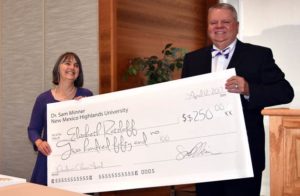
- I recently signed an NCAA Diversity Pledge committing HU to promoting diversity in our athletic program. Here’s the pledge:
Consistent with our mission and values, our institution, a member of the National Collegiate Athletic Association, pledges to specifically commit to establishing initiatives for achieving ethnic and racial diversity, gender equity and inclusion, with a focus and emphasis on hiring practices in intercollegiate athletics, to reflect the diversity of our membership and our nation. We recognize and value the experiences individuals from diverse backgrounds bring to intercollegiate athletics. To that end, we will strive to identify, recruit and interview individuals from diverse backgrounds in an effort to increase their representation and retention as commissioners, athletics directors, coaches and other leaders in athletics. As part of this commitment, we will also engage in a regular diversity, inclusion and equity review to inform campus policy and diversity initiatives. We understand this to be a collective responsibility we owe to student-athletes, staff, our athletics programs and the entire campus community.
AD Clifford and I take this pledge seriously and we will do all we can to live up to the ideals in the pledge. Diversity is such an important component of life in our nation and here at HU. I do not see it as some obstacle to overcome or standard to meet and then move on. In my view, we need diverse opinions around tables where important decisions are made. That adds to the strength of our institution and will result in better outcomes here. I signed the pledge on behalf of our institution without reservations.
- Our Office of Outdoor Recreations continues to engage our students in fun, healthy, and interesting outdoor activities. Last weekend, numerous students did a hike and had an interesting outdoor experience at White Sands. A few of our students expressing their Highlands pride:
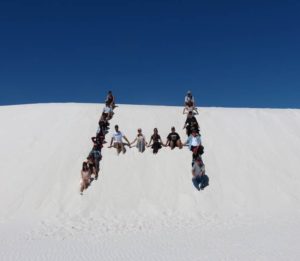
- I met with the Sodexho team (our new provider) on Wednesday and we are moving forward with the possibility of making some changes to our dining services. Nothing is set at this time. Sodexho has done a nice job of surveying the students, staff, and faculty. More on this as things evolve.
- Last week, I shared several “lessons learned” from the individuals who attended the HLC meeting in Chicago. Here are as few more…these from Regent Lou Ella Marr-Montoya:
- Opportunity– Turn accreditation into “opportunity.”
- Accountability–The matter of accountability across campus and its effect on accreditation. Accountability is paramount.
- We must assure our quality and provide evidence: Assessment, effective planning, process and quality to improve student success and success across campus and the sites.
- The pressure and challenges facing our colleges and universities, accountability, the federal and state agendas, innovation strategies, diversity, academic freedom, “What is our college message?”, student access and success, quality assurance, persistence and completion and many more. The title of the conference, Navigating the Future, is certainly real and of great meaning.
This Week in HLC Accreditation (from Dr. Kempner): A few quick updates before the holiday weekend. We have our next HLC Forum on Monday (4/17/17), and this will serve as our mid-point update. We have approximately six more months before our Assurance Argument is due to the HLC, and I’ll be discussing what we’ve done for the probation areas and what we still have left to do. Our new Provost, Dr. Roxanne Gonzales, began this week, and she brings a wealth of HLC and accreditation experience to our team. She will be joining the HLC Steering Committee beginning next week.
Sam Minner,
President
Greetings colleagues. A brief update for the week of April 3-7:
- I asked members of the HU contingent who attended the HLC meeting for some “lessons learned” from the conference. Here are a few:
from me:
o instability and some anxiety: university presidents are unsure of the future, particularly funding and potential federal policy changes under the new administration,
o the future of accreditation: the deregulation environment in Washington may also result in major changes in accreditation and could even eliminate accreditation as we know it altogether,
o tools can help, but they all cost something: there are many tools out there to help universities become more efficient. Many of them also help with accreditation. The benefit vs cost analysis will ultimately determine if these are good for HU, and
o most desired job skills: hundreds of thousands of jobs across all sectors were analyzed and the most common skills across all of them—–refined communication skills (oral and written) and knowledge of and skill with Excel.
from Dr. Kempner:
o persistence and completion: this will be one of the HLC’s new points of emphasis moving forward, particularly how institutions are attempting to improve 4 and 6 year graduation rates and
o resolving probation: our liaison emphasized once again that the HLC’s action letter is our “roadmap” for addressing all HLC issues and concerns.
- Still no budget for the state of New Mexico and Friday is the deadline. Here’s one article about the budget showdown: https://www.abqjournal.com/983504/suspense-mounts-as-deadline-nears-for-gov-to-act-on-220-bills.html. Things are hardly great in New Mexico, but contrast our situation with those in some other states—like Illinois. I was in Chicago a few days ago and drove past Northeastern on my way to the airport. Some pretty nice buildings. A few students strolling around. But…the budget issues are so serious there that the president is cancelling three days of classes, closed the campus one entire month, and imposed furloughs on 1,100 employees. Wow. Just wow. If you want to read more, go to: http://abc7chicago.com/education/neiu-to-cancel-classes-for-3-days-due-to-state-budget-impasse/1842056/.
- Good things continue to happen in regard to external funding. A few weeks ago, Dr. Erika Derkas submitted a grant 2 weeks ago. The purpose of this grant is to organize a Fulbright-Hays Group Program Abroad titled, “Kazakhstan and Kyrgyzstan: A Cultural Crossroads.” This proposal , organized by Dr. Derkas in collaboration with the University of Arizona (UA), Center for Middle Eastern Studies (CMES) seeks not only to develop a unique enriching experience for college educators and K-12 teachers involved, but promises to have a wide-ranging impact on the educational community as a whole. Dr. Jiao Chen, Department of Chemistry submitted a proposal to the Society for Analytical Chemist of Pittsburgh for $40,000.00 as a starter grant. She also submitted a Seed grant to help her with her project on Facile and Green Synthesis of Fluorescent Graphene Quantum Dots from Amino Acids and Their Potential Applications as a neurosensor for Memory Detection. Thanks to these good faculty members for truly going above and beyond to submit these applications.
- Our TAG program (that’s the email recruitment initiative we are doing) is underway and soon, we’ll have some data regarding the effectiveness of the effort. I’ll share that with the campus when we start receiving the information. We are also close to signing an MOU with a university in South Korea. If all goes according to plan, we’ll welcome up to 40 students per year to our campus. All of them will come with full scholarships from their home country. Many thanks to Dr. Edward Martinez and Ms. Tina Clayton for working on this.
- Our Advancement Office continues to aggressively pursue private giving to support our efforts to strengthen HU. We are in close contact with multiple donors in regard to our athletics facilities. We are also in final negotiations to initiative a Washington D.C. internship program which will support one student per year and provide that student with an introduction to the federal government. More on all this once the gifts are finalized.
- While I was gone last week, HU sponsored a very well attended event focusing on campus sexual violence and our efforts to combat that problem. Well done to Ms. Kim Blea and everyone who helped make the event a success. I heard we had about 300 in attendance.
- From Dr. Kempner: This Week in HLC Accreditation—President Sam Minner, VPFA Max Baca, VP-SEM Edward Martinez, Regent LouElla Marr-Montoya, and me (Brandon Kempner) all attended the HLC conference in Chicago this week. It’s an extremely large conference, with thousands of attendees. The HLC uses this conference to share information about the latest changes in the higher education landscape and to update us on the accreditation criteria. There was a lot of good information we learned at the various presentations, ranging from information about financials, to persistence and completion (the HLC’s big focus over the next few years), to life after college, to student success, to faculty credentials. We were also able to meet our HLC Liaison, Anthea Sweeney, who will be helping us through our probation process. The information we learned was very valuable, and we’ll be using it to improve our Assurance Argument as the HLC workgroups continue their writing efforts.

Sam Minner,
President
Greetings colleagues. A brief update for the week of March 27-March 31:
- The Governor is considering mandating furloughs for a number of state workers to address the budget shortfall. This all could happen fairly soon if revenues continue to fall as they have in recent months. Here’s the story:
http://www.sfgate.com/news/article/New-Mexico-governor-to-discuss-bitter-legislative-11030513.php. Update—I wrote the previous sentence on Monday. Here’s the latest: https://www.abqjournal.com/974983/nm-governor-imposes-hiring-freeze-warns-of-potential-closures.html.
- On Monday, I attended several meetings with visitors from the NSF who are taking a look at our PREM program. Members of the panel toured our facilities and visited with the faculty and the students associated with the program. The panel will issue a report and based on their recommendations, we’ll take a look at making some possible changes in the program. That program is important to HU and so many good things have happened there, but there is always room for improvement and we’ll take a look at making a good program even better.
- We held the bi-monthly Leadership team meeting on Tuesday and began the meeting with a brief discussion about giving and receiving feedback as well as attempting to assess the soft skills and “fit” of a person being considered for hire in an organization. We read and discussed this: https://www.nytimes.com/2017/03/16/business/mark-nathan-zipari-health-insurance.html?rref=collection%2Fcolumn%2Fcorner-office&action=click&contentCollection=business®ion=rank&module=package&version=highlights&contentPlacement=2&pgtype=collection&_r=2. Essentially, the author of this article asserted that providing people with direct and honest feedback is the only way they can grow as leaders and potentially become top performers. He felt that providing such feedback was pretty rare. We discussed if it was rare in our work—the academy. People shared different experiences about all this, but my sense was that most folks did feel that we were pretty easy on each other. Maybe that was because all the sorting and selecting to become an academic was pretty rigorous and as a result, most everyone was high performer if they made it through that gauntlet. We also discussed the possibility that people drawn to higher education are not people who enjoy giving or for that matter, receiving direct feedback. There were some other thoughts as well.
- On Tuesday at noon, I led a discussion at one of the staff development workshops—the Learning Happens Here Series. I talked about Critical Theory as it is applied to different social contexts (e.g., schools, work settings, etc.). We talked about dominant and subordinate groups, hegemony, and different forms of ideological hegemony. I thought it was a great discussion and a lot of fun (for me, at least). We had a full group at the meeting—all slots were taken. Thanks so much to Staff Senate President Laird Thornton and Director of HR Dr. Denise Montoya for organizing these sessions. Universities are (or should be) about learning. That should come first…this is a good example of how that is manifested at HU.
- Later that Tuesday, I welcomed an energetic group of prospective students from Robertson High School. We talked about the many reasons to attend HU including (1) Value (a combination of cost and quality), (2) High-Impact Practices (HU students do not simply sit in lectures), (3) Campus Life (the renewed focus on healthy and fun social and recreational activities), and (4) our efforts to engage each of our students in a “family” manner (e.g., individual attention, assistance as needed in order to succeed, etc.). It was a nice meeting and many students demonstrated high enthusiasm for HU. Some of the Robertson students:
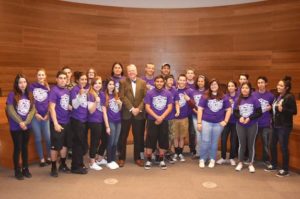
- Even later on Tuesday, we hosted another HLC Forum. Dr. Brandon Kempner, Mr. Max Baca, and I focused on the fiscal issues noted by the HLC, particularly the CFI (a measure of our overall fiscal health) and the process used to budget against our mission. About 50 people attended the forum. We had several folks participate at Centers. For those unable to attend the meeting, it is available on the HLC website.
- Tuesday was a busy day and ended with a student dinner at the University Residence. Several of our international students attended the function along with Ms. Tina Clayton and Dr. Edward Martinez. We hosted students from Russia, El Salvador, Ukraine, and Jordan. It was really a great evening with lots of good conversation. A photo from the event:

- On Wednesday, I attended another City of Las Vegas Housing Committee meetings. I want to keep the city (and others) in the loop as we move toward the development of the golf course to include some residential options. Also on Wednesday, I welcomed a large group from the Society for Applied Anthropology to Northern New Mexico. The group was holding their meeting in Santa Fe and I welcomed them on behalf of NMHU. Dr. Orit Tamir was instrumental in bringing the conference to our area. A photo of me pounding a point home:
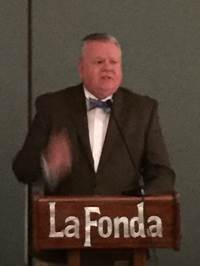
- It was another good week for HU grants. This week, the Office of Research and Sponsored Programs ( ORSP) submitted a NSF Scholarships in Science, Technology, Engineering, and Mathematics (S-STEM) proposal. Like always, I believe that our proposal will be competitive. Professor of Biology, Dr. Miki Ii, was asked to take the lead as PI. She accepted the challenge and delivered. Ms. Cecily Peterson from The Grant Plant did an awesome job in keeping us on task and helped with the editing, framing, and writing the proposal . Again everyone listed above provided something to the development of the grant proposal and of course the intrepid Dr. Jim Alarid kept everything moving forward. We asked for $600,000+ with 60% going to scholarships. Let’s keep our fingers crossed. Speaking of Dr. Alarid, he was recently approved to serve a three year term on the Board of Quality New Mexico. Their website: https://www.qualitynewmexico.org/who-we-are/.
- After input from the Interim Provost and the President of the Faculty Senate, Professor Beth Massaro has been selected as the 2017-2018 President’s Leadership Fellow. Beth will begin her duties at the beginning of the fall term, 2017. I was so impressed with Beth—super smart, great energy, new ideas, and on and on. Congratulations to Professor Massaro! We will all wind up working for her someday, no doubt.
- On Thursday, I met with the representatives from West Las Vegas, folks from the City of Las Vegas, and others to talk about developing a summer program for the youth in Las Vegas. It was a good meeting with many good ideas put on the table. Let’s see what happens….
- This Week in HLC Accreditation (from Dr. Kempner): We’re at the HLC Annual Conference in Chicago from Friday-Tuesday, so no update this week. If you missed Tuesday’s (3/28) HLC forum, this one on the budget.

Sam Minner,
President
Greetings colleagues. It was spring break on the HU campus this week and few students around, but lots of things still going on. A brief update for the week of March 20-24:
- Quite a buzz around the state about this article: http://www.santafenewmexican.com/news/education/report-new-mexico-leads-nation-in-in-state-college-affordability/article_2bcc9192-8e69-59ba-940a-6f7088d95795.html?utm_source=The+Santa+Fe+Reporter+List&utm_campaign=90789bb265-Morning_Word_Mar.+20%2C+2017&utm_medium=email&utm_term=0_b77a98714b-90789bb265-60534221&mc_cid=90789bb265&mc_eid=88160857a2. New Mexico may be 49th or 50th in so many measures of performance, but we are THE most affordable state in regard to in-state tuition. I think that is something to be proud of. We should all be happy about that. Looks like there will be a Special Session: http://krqe.com/2017/03/18/governor-martinez-calls-for-special-session/. Also (as if anyone needs further evidence of the state’s budget travails), the Governor has mandated a freeze on hiring in the agencies she controls and the possibility of temporarily closing state parks and museums. Go to: https://www.abqjournal.com/974983/nm-governor-imposes-hiring-freeze-warns-of-potential-closures.html.
- The Longmire crew was on campus Tuesday and Wednesday. They filmed several scenes including a couple in Rodgers. Thanks to everyone who was inconvenienced during the shoot. I know it was a hassle, but HU was paid for our trouble, I assure you. I understand the crew is shooting the final season of the show.

- Numerous grants have been or will soon be submitted by great HU faculty. These are our colleagues who layer all of this up-front work on top of their other duties. Why? To help our students. To make HU stronger and more vibrant. Because they are extraordinary professionals.
Grant aficionados Jennifer Lindline and Mike Petronis recently submitted a proposal to the National Institute of Food and Agriculture to support an exciting project titled Promoting Undergraduate Perception, Preparedness, and Placement in Water Resource s Management Career. If funded, this $250,000 project will begin August, 2017. Thomasinia Gallegos, Pat Cruz, Bob Karaba, and Dr. Abeyta recently submitted a $138,000 grant to support a Title II grant. Dr. Blanca Cespedes recently submitted a grant to the USDA. If funded, this four year $999,999 project, among other things, will support NMHU students to complete internships at the John Harrington Tree Research Center in Mora. Many thanks to Ms. Angela Juarez who was literally ill and rallied to help submit this grant on time. That my colleagues…is commitment. Miki Li, Carol Linder, Richard Medina, Jiao Chen, and Jennifer Lindline submitted a grant to the NSF to support students in STEM disciplines.
This is extraordinary effort. I thank everyone who made the last week a great one for efforts to win external dollars. Well done.
- Things continue to go very well in regard to the Campus Life initiative. I saw a recent photograph of the Outdoor Recreation center and it was virtually empty—everything had been checked out. We are selling tickets to the community for the upcoming reggae concert and things are coming together for next year’s lineup of performances. At this point, we have a duo of comedians coming in the fall, an illusionist makes a return visit to the HU campus, an interesting hip hop rendition of the Nutcracker (hmmmmm…), a group of contemporary violinists, a ballet, and hopefully, a country music performance. It is my hope we can get all these performers booked early enough to devise a large poster of all acts over the academic year. This should help students…and others…in their planning and scheduling.
- The second email in our TAG Campaign…this is the email recruitment campaign we are undertaking in conjunction with RNL…will be sent today with additional email contacts sent April 1, 9, 18, and 27th and May 5 and 21st. Students who demonstrate some interest in HU will also receive hard-copy materials and phone call follow-ups. We are contacting approximately 57,000 prospective students in this campaign.
- A few weeks ago, Joan and I hosted a dear former student from our time in Missouri. She was in the McNair Program and I was a McNair mentor. She also worked for Joan as a student worker. At the time, Joan ran the institution’s program in Advance Placement (AP). We trained AP teachers from across the state and the nation, particularly in the liberal arts disciplines we specialized in at Truman State. We had so many connections with the student that we became quite close and we think of her as more of a family member than anything else. As a student, everyone could see she was super bright and undoubtedly headed for some type of academic career. She is now finishing up her doctorate at a university in the Midwest, specializing in Women’s Studies and related disciplines—some of which, frankly, I had never heard of. We had some great talks every evening and I was struck by the many concerns she had about entering the job market in academe: Would there be a job for her?, Will her academic specialty be marginalized or possibly eliminated altogether given the current political climate?, and on and on. I’ve heard many of these concerns over the years and truth be told, I experienced some of them myself many years ago, but they seemed more intense now. More troubling. And, that got me thinking about the future of the academy and the work we do. I spent an hour or so one evening perusing what others have to say about careers in higher ed these days. I focused on becoming a professor—not an administrator, staff member, or something like that. I suppose there are some people who aspire from the very beginning to take some non-faculty job in higher education, but I’m not sure I’ve ever known one. I mean, have you ever heard a 25 year old person say their dream job is to be the Associate Vice Chancellor of Student Success and Accreditation or something like that? I haven’t. Some people wind up in those kinds of job, but starting that way? I don’t think so. So, I focused on what I think most people think of when they think about a job in higher ed.—a faculty job and a faculty life. As I poked around the internet, people were all over the place ranging from…don’t even think about…like this piece…
“Finally, I want to look at one factor that is too-little addressed in these discussions: the opportunity costs spending 6-10 years preparing for a career that, even in the event of your actually landing a tenure-track job somewhere (and again, that is not going to happen) will leave you hundreds of thousands of dollars in the hole compared to your friends who started professional careers right out of their undergrad program. In six years you could have entered a career, risen to mid-rank, bought a house, and had your IRA off to a healthy beginning. If you go on for a PhD, instead you will find yourself with student loan payments equivalent of a home mortgage but no home (and no equity), no retirement savings, and banking on the thin chance of landing a job in some part of the country usually only seen on American Pickers. The opportunity costs are at least a million dollars. You don’t care now, because you are young, but you will.”
…to even more gloomy comments like this one, “Don’t do it. It is the first step to hell.” Wow. It sounds like that person had a great higher ed career. Frankly, it was hard to find much about the advantages of becoming a professor these days. I really didn’t look that long, but I couldn’t find much. Here’s a positive spin that is a little old: http://www.chronicle.com/blogs/innovations/why-i-like-being-a-professor/27958. The negative postings are in stark contrast to my own view of the situation. I thought and still think of my time as a faculty member as pretty great. I really liked being around students. I liked teaching my classes. I liked doing my scholarly work, writing grants, and so on. I really liked working with smart people who enjoyed many of the same things and ideas I cared about. Mostly they were also good people and fun to be around. There were some jerks, of course,—-email flamers, people who were cynical and or negative about so many things, people who acted like they were superior to others, a few who felt kind of stuck and were very unhappy, but could not leave due to one reason or another, self-absorbed bores, the person who just can’t help but interject in any and all conversations something about their academic pedigree, etc.—but as a faculty member I found that those folks were rare and I could mostly avoid them if I wanted to do so, which is frankly, from my perspective, one of the many advantages of working in higher education. My time as a faculty member was interesting, often exciting, and mostly fun. There were stressors, of course, but they really seemed fairly tame compared to those some of my friends working in business experienced and the occasional fun, but frequent utter terror people experienced who pursued business start-ups. Try that if you want some work related anxiety. The administrative jobs I’ve had have also been very positive and enjoyable…even fun most days. Most of the administrative jobs I’ve had precluded much involvement in my discipline, but beyond that, most of the great things about being an academic were evident (to me, at least) in my administrative work—being around students, doing things I thought had some chance of making the world a better place, etc. No heavy lifting. But, as I wrote, I sure could not find much online about the good things about being a professor. I wondered…was I some weird outlier? This week, I spoke to three—only three—of my HU colleagues about this and…they seemed to pretty much feel the same way I felt. Overall, they were positive about their jobs here and their careers in the academy. True, there were and are challenges in our work and fiscal challenges were specifically mentioned by each person. I am not minimizing that or being cavalier about it, but you know…I have worked at numerous institutions over many years and budgets and fiscal pressures have always been a problem. Every place. Every year. Oil at 75 dollars per barrel and oil at $25. Strong budgets at the state level and weak budget including deficits. No matter…there has never been enough money to do what everyone wanted to do and in some cases, needed to do. I wondered…how can that be?
Getting back to our guest—I did encourage her to finish and not listen to those who told her she would not find a job and or that the life of an academic is a bad one reserved only for those who can’t make it “in the real world”—whatever that means. I reject that and in the end, so did she. I was very happy about that and left the conversation very optimistic about the future of the academy. When I heard her talking about teaching students, sharing her ideas with them, writing books and articles, wondering where she’d wind up, etc., I was encouraged and it brought back vivid memories of me as a twenty-something year old shiny new assistant professor. The future of our work is challenging—maybe it always has been—but I consider it a privilege to do what I (and we) do. I feel I am lucky and in the end, even with all the daunting issues before us, this young person sitting on my sofa in Las Vegas, NM was excited about joining the academy. Hurray for that.
I don’t think we talk much about this kind of thing. In retrospect, was the academic choice a good one for us? Is it a good choice for someone now? Would we recommend that choice to others? What do or should we say to our students who are thinking about a career in higher education? Maybe working to become a hedge fund killer really is a better career path. Maybe. I don’t think so. If anyone wants to have that conversation in an informal setting, just let me know and we’ll arrange some type of brown bag session or something along those lines.
- We will soon schedule our “Big Ideas” discussion of the book Austerity Blues. The HU contingent will join a group of faculty from Northern New Mexico and Rick Bailey, the President of Northern, for a good discussion. I heard one of the authors of the book on NPR the other day. He was really interesting and quite articulate. We’ll try to get him to Skype into our conversation.
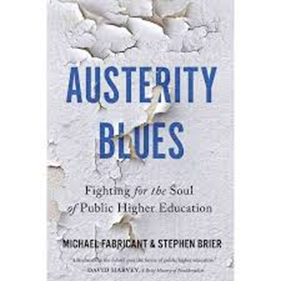
- Our Advancement Office has been doing very well with the Home Field Advantage campaign. We recently put a major gift agreement in front of one donor and are actively working with several other donors to win additional six-figure gifts. On Tuesday, we received $2200 in the mail to support the Home Field campaign and another $5000 check on Wednesday to support an endowed scholarship. Gifts large and small all count of course, and we appreciate each and every one of them. We are also close to finalizing a gift to support a new Washington, D.C. student internship program. Many individuals played a role in winning these gifts, but special mention should be made of the efforts of Vice President Terri Law and Athletic Director Bob Clifford.
- From Dr. Kempner—This Week in HLC Accreditation: We have our next HLC Forum on Tuesday 3/28, from 2-3 in the SUB ballroom. We’ll be discussing finances, our CFI (Composite Financial Indicators), university reserves, capital planning, and strategic budgeting, all important areas of concern for the HLC. Later in the week, President Minner, VP-SEM Edward Martinez, VPFA Max Baca, and I will all be attending the HLC annual conference. Regent LouElla Marr-Montoya will also be attending the meeting. This should provide us with a chance to get acquainted with the most recent HLC policies and to discuss best practices with a wide variety of experts.

Sam Minner,
President
Greetings colleagues. A brief update for the week of March 13-17:
- As of the writing of my message, the Governor has not signed a budget. Our sources suggest that we should prepare for up to a 7% cut in general appropriations funding. Of course, it could be less than that. For HU, the 7% is approximately $2.1mil. We will also have to meet our unavoidable additional costs such as promotions, increased insurance costs, increased energy costs, escalators on software, and others. It is also possible that the Governor will sign an overall increase in the minimum wage. I fully endorse that action, but if approved, we must also find the resources to fund that increase using existing resources—we will not receive any additional state funds if that goes into effect. It would mainly impact our student workers and our budget to support student work. I’ll keep in touch with the campus as things evolve.
- On Monday, I traveled to Gallup to do some recruiting at the high schools there. I visited with several students and met with school officials to learn about their interests/needs. Several students expressed interest in HU. One of them spoke of HU’s “great reputation in teacher education” and I also heard good things about our Social Work program, our program in Forestry, and Media Arts. A photo of the HU recruiting table in one of the high schools—I should note we were competing against recruiters from the United States Air Force, one of whom was an HU graduate:
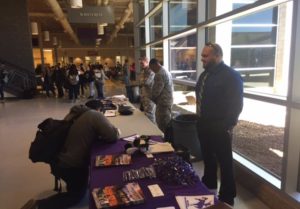
- A good former colleague contacted me recently and informed me of his new role as the leader of an effort on his campus to establish some type of competency-based program(s). That is not a new idea, but those program are pretty rare at most public institutions. On Tuesday, the HU Leadership Team met and we began the meeting with a discussion of the College For America (CFA) concept at Southern New Hampshire University. We read this: http://collegeforamerica.org/about-college-for-america/. The College For America is a competency-based approach to higher education where faculty establish competencies for certain programs and students demonstrate their ability to know and do things resulting in the award of the certificate or degree. For example, if a student demonstrated knowledge of certain statistical concepts (e.g., t-test, ANOVA, post-hoc tests, software programs to do these things, when to use which kind of test, etc.), they would do so in an established manner, faculty would determine using pre-established rubrics if they achieved the competency level, and if they did—the student would be awarded the degree, certificate or whatever. In this model, learning is de-coupled from time. A student moves through the competencies as quickly or as slowly as they desire. Proponents of this approach like to talk about the fact that there is no grade inflation in the system. It isn’t possible. Students meet the competency or they do not. The number of minutes someone sits in a class is not relevant. One proponent asserted that this approach was a truly “democratic form of learning” where students set the pace. I’ve also heard a proponent assert that CBE is the “next evolution” in higher education leaving behind the “antiquated” model that students must travel to where learning occurs, structure their lives around pre-packaged 15 week sessions of instruction, and move through the material at a pace dictated by the instructor instead of their ability and motivation. Hmmmmm—a pretty bold claim. The model is basically designed for adult learners and as was noted at our meeting, it works better in some situations than others. It may be fine in say, a stat class, but try to establish competencies in a class about say…Holocaust Poetry. Try to “measure” learning outcomes for that class and have students demonstrate competency. That would be tough—maybe impossible (go to: www.chronicle.com/article/Keep-Your-Hands-Off-the/128804/. Another feature of many competency-based programs is that they are often marketed to businesses as an employee benefit instead of to the individual student. For example, let’s say employees at a given unit at LANL need some fundamental math and or statistical skills—quadratic equations, computing a regression coefficient, or it could be basic arithmetic stuff—fractions, percentages, etc. In some competency-based programs, deals are made with employers to pay a flat tuition for x number of employees to get access to the program. At the College For America, that flat fee is $3,000. The company pays the fee and the designated employees gain access. Employees may spend as much or little time as they wish on the program, but there is never an additional fee…the 3K is it. As I wrote, this approach is basically designed for adult learners and that, I should note, is one of the few growing areas of students in need of/interested in higher ed. The number of eighteen-year old students is flat across the country (or shrinking), but the adult population is in need of more higher education and they want it. But….it has to be done in ways that work for them according to their schedules, their needs, etc. In many cases, adult learners with families, jobs, mortgages, kids, etc., etc. are simply not going to participate in a traditional 15 week class meeting every Wednesday evening from 5-8:30. For that kind of student—a synchronous online class is probably better. An asynchronous online class is probably even better and a CBE type class is perhaps the best of all. We had a good discussion about all this at our meeting. Faculty Senate President Elect Ian Williamson and Provost-To-Be Roxanne Gonzales joined us. To my knowledge, no one in New Mexico is experimenting with the competency-based idea. We debated the questions—Should we try this?, If so, what is the best way forward?, What HU certificates or other programs might work?, and others. My take—would this distinguish us from others—yes. Should we try it—maybe. Let’s discuss and to the degree possible, decide together.
It is my opinion that we should do all we can to differentiate ourselves from our peers in the state and to the degree possible, the region and beyond. The traditional college-aged student is no longer around in the numbers we saw even a few years ago. There are fewer of them and the competition to enroll them among institutions that do pretty much the same thing is intense beyond belief. To merely keep doing business as has been done in the past may be comfortable, but I don’t think it is wise in regard to growth or in some cases, even maintaining viability. I’d welcome anyone’s thoughts on this. The remainder of the meeting was devoted to budget issues, an HLC update, and a few routine management matters.
- A number of our students participated in the Tent Rocks hike last weekend. Our Office of Outdoor Recreation organized the trip. Students met on campus and were provided with a backpack (if needed), water, an orientation to the hike, and transportation to the site and back to campus. It was a beautiful day to get out in the great outdoors of New Mexico. A photo of the group and a second photo of Joseph signaling that a weary hiker will be OK:
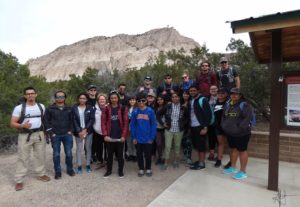
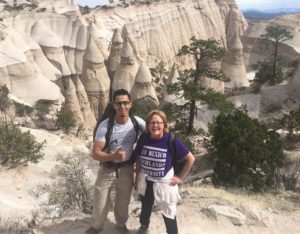
Also in Campus Life, advance tickets recently went on sale for the JBoog/Common Kings reggae concert. Our students, of course, will pay nothing at the door. On the first day tickets were available, we had a line of interested members of the community wanting to buy them. We’ll run radio ads and print ads to advertise the event. As was the case with the comedian we brought to campus last fall, ticket sales from community members will be put into the Arts@HU fund to further benefit our students. As you may know, JBoog was nominted this year for a a Grammy so he has quite a national and even international following.
- On Tuesday evening, Joan and I hosted the Emeriti Faculty at the University Residence. More than 30 emeriti attended. I provided them with an update on campus happenings and answered some questions about various issues. It was a very nice event and it is my intention to continue to engage this faculty group into the future. So many good things at HU rest on the shoulders of those who came before us and we should remember and honor that. A photo from the event:
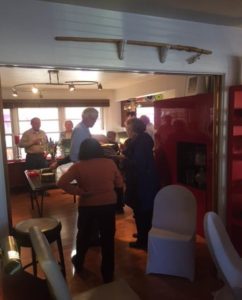
- Given the current fiscal situation, we are on the constant lookout for ways to bring in additional resources. Given that, we have comes to terms with the Longmire folks and their crew will once again be filming in Rodgers. The filming will occur next Wednesday. Thanks to all who will be temporarily displaced and inconvenienced during the filming.

- HU recently sent several of our wonderful women student athletes to Birmingham, AL to compete in the NCAA championship. While there, our student athletes participated in a service learning activity at Jones Valley Middle School, located in one of Birmingham’s poorest neighborhoods. The athletes organized demonstrations of various athletic events and provided words of inspiration to the kids at Valley Middle. In the words of an NCAA official, the HU student athletes were “rock stars” throughout the day. This is a high testament to Coach DeVries, our student athletes, and our institutional commitment to Division II athletics which stipulates a “life in the balance” approach to academics, athletics, and personal growth and development. A photo of our wonderful student athletes “making a difference” in Birmingham:
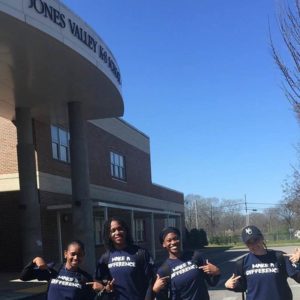
- On Thursday evening, Joan and I welcomed numerous HU faculty and staff at one of “Power Of Excellence” events—this one focusing on successful grant writers at HU. These events were recommended by Interim Provost Carol Linder and I have enjoyed them very much. Most organizations spend too little (much too little) time celebrating the many accomplishments of high-performers in the organization. These Power Of Excellence events are but one way to address that issue. Thanks to everyone who attended and thanks to Carol for getting this set up.
- Friday was totally devoted to the HU Foundation. Breakfast was early in the a.m. followed by a full day meeting of the board followed by an alumni reception in the afternoon. As usual, VP Law and her team did an exceptional job with all this. Everything was very professional. In regard to Advancement, we continue to accept gifts for the Home Field Advantage Campaign and continue to speak with several donors interested in making a large gift. More on that once the details are settled. I am optimistic.
- From Dr. Kempner—This Week in HLC Accreditation: Our 2016-2017 HLC Institutional Update is being finalized, which is our annual report to HLC about our enrollment numbers, faculty/staff numbers, and our financial indicators. This is how the HLC keeps track of our data, and is basically our “official numbers.” Some interesting pieces to consider: we had 2066 degree seeking undergraduates and 1055 degree-seeking graduates in 2015-2016 and a small handful of non-degree seeking students; we had 2080 full time students versus 1183 part time students. We had 135 full time faculty, down only 1 from last year, and 144 per-course faculty, up 3. Our administration has declined the most, from 187 full-time administrators to 172 full-time administrators. For staff, we reported 150 full-time, up from 138 full-time the year before. I’ll be sharing the full report when it’s finalized on our accreditation website. On Friday (3/17), our VP of Advancement Terri Law and I will be presenting our mission to the NMHU Foundation Board for endorsement. It’s important that the entire campus community, from students to faculty to the foundation to alumni, be part of our mission and help achieve our strategic goals, including being a strong community partner.

Sam Minner,
President
Greetings colleagues. A brief update for the week of March 6-March 10:
- This week, the ABQ Journal ran a series on New Mexico higher ed and it has attracted some attention. The gist—-dwindling enrollments across the sector and diminished funding from state government is resulting in serious problems in New Mexico higher education. Here are the articles:
https://www.abqjournal.com/962261/nms-higher-ed-crisis-state-cuts-fewer-students.html
https://www.abqjournal.com/962502/budget-cuts-force-nmsu-to-make-hard-choices.html
On Tuesday, the New Mexico presidents appeared before the Senate Finance Committee in Santa Fe. Chancellor Garry Carruthers spoke on behalf of the Council of University Presidents and President Steve Gamble (Eastern) spoke specifically on behalf of the comprehensive institutions. A photo from the hearing: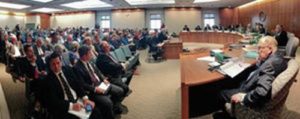
- We were recently informed that Regent Frank Marchi was reconfirmed by the legislature and John Ramon Vigil was confirmed as the NMHU Student Regent. Congratulations to both. Our current board—Regent Leveo Sanchez (Chair), Regent Sandy Turner, Regent Frank Marchi, Regent LouElla Marr-Montoya, and Regent John Ramon Vigil (Student Regent).
- Provost & VPAA Roxanne Gonzales was in town this week and she met with a variety of folks in preparation for her first day on the job—April 10. Shortly after she arrives, we’ll host a meet and greet for her to welcome her to Las Vegas and HU. Thumbs Up…looks like she is ready to get to work:

- Dr. Lail arranged for a nice showing at Graduate Education Day at the legislature and he heard many positive comments from HU alums, current students, and good friends of HU. Our banner in the Rotunda:
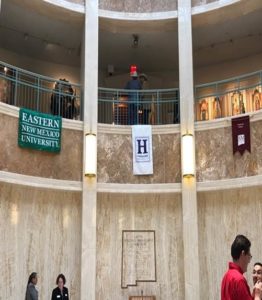
- One of our alums was recently honored by the American Fisheries Society (AFS). Marc Wethington received the Lifetime Achievement Award at the meeting of the AFS in Farmington. Marc’s work has exclusively focused on the San Juan River—one of the premiere trout fisheries in the nation. Going to work every day on the San Juan….sheesh, does that guy have the best job in the world or what? A photo of Marc and a rather incredible trout:


- Things are moving along in regard to the planning for next year’s Homecoming. We’ve ordered another horse to add to our remuda. If you want to explore adding some disciplinary or special Homecoming event, please email Ms. Juli Salman at jesalman@nmhu.edu.

- Our Office of Outdoor Recreation continues to attract high student interest. The next event (this Saturday) is a hike at Tent Rocks. Interested students sign up for the hike, we provide a backpack and water, and we transport everyone to and from. Several of our students and staff recently participated in a 16 hour Wilderness First Aid Training at the Albuquerque Academy. The participants were Peer Resource Leaders (PRLs) at the Outdoor Recreation Center. These PRL students will be leading hikes, camping trips, etc. and helping other students acquire new outdoor interests and skills. Of course, the students trained in wilderness first aid will also provide another layer of safety for our students. The flier for the Tent Rocks event and a photo of some of our students at the first aid clinic:
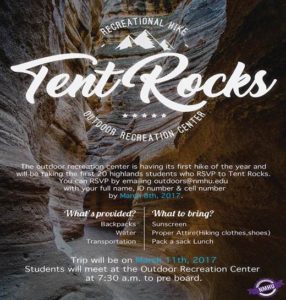
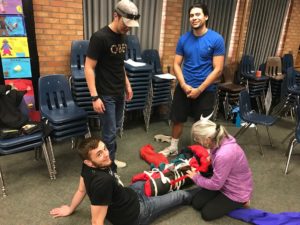
To provide even more healthy and fun options to our students, we are also adding more intramural sports to our portfolio. For example, we now have eleven intramural basketball teams on our campus. That shot doesn’t look like it is going in…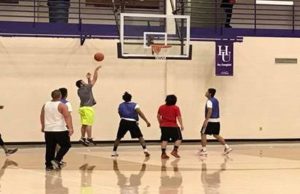
- On Wednesday I held the monthly “Coffee With The President” session. About 70 people attended that event and I thank them for it. Later that same day, I welcomed a group of about 40 students from Manzano High School to our campus and made certain they were familiar with the many benefits of an HU education. Selfie of me and the students from Manzano:
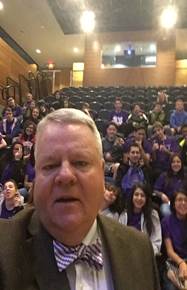
- On Thursday, I attended a meeting sponsored by the LANL Foundation. The meeting focused on the Foundation’s interest in establishing a Math and Science Academy (MSA) in Northern New Mexico. The MSA will be a partnership involving an institution of higher education (hopefully, HU), a local school, and the Foundation. The purpose of the MSA is to build and implement a model partnership improving math and science student achievement and getting more students into the STEM pipeline. Another goal is to improve teacher training. The basic design of this project is consistent with Professional Development Schools (PDSs), which are patterned after teaching hospitals in the medical domain. HU will be submitting a proposal to win this project.
- Many positive changes continue to occur in Strategic Enrollment Management. Dr. Martinez and his team returned from their Chicago trip with 119 completed Contact Cards. These prospects were high school juniors so we’ll cultivate them and hope to see them on campus Fall, 2018. On April 7, Brian Edward from Ruffalo Noel Levitz will be on the campus to provide additional technical assistance as we move closer to the time we can handle modern enrollment management ourselves. Also in April, we’ll welcome groups from three local high schools to the Rio Mora Refuge for STEM Recruitment events. The students will get some hands-on experiences at the Refuge and of course, they will be encouraged to consider HU when they make a college choice. In June, we’ll welcome about 40 students from Tesuque Pueblo to the campus for the Tesuque Mock College. Students will spend the night on campus and participate in a variety of tours, lecture/discussions, and social activities. We are also pushing out our new visual identity on promotional materials of various types. Note the new “H” identity and the “family” theme on our new poster (below) and the new “HU” identity on the shirts our recruiters will wear (also below):
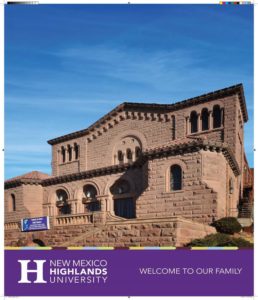

- Professor Kerry Loewen’s massive photograph of Star Axis is a big part of a new show at the Los Angeles County Museum of Art. As many of you know, Star Axis, located very close to Las Vegas NM, is a huge piece of earth art by the renowned artist Charles Ross. I know that some HU folks have visited Star Axis. Some have not—access is by invitation only. I have been there several times and it is quite frankly one of the most incredible things I have seen. A brief description of Star Axis and Professor Loewen’s work as it was displayed at the National Gallery of Art:
Star Axis is an architectonic earth/star sculpture constructed with the geometry of the stars; earth-to-star alignments built to human scale. It offers an intimate experience of how the earth’s environment extends into the space of the stars. This architectonic earthwork has five main elements. The Solar Pyramid marks the daily and seasonal movements of the sun across the Shadow Field. From inside the Hour Chamber you can view one hour of Earth’s rotation, and from inside the Equatorial Chamber you can observe the stars that travel directly above the equator. The Star Tunnel is precisely aligned with Earth’s axis. Here the viewer can walk through layers of celestial time, making directly visible the 26,000-year cycle of precession, Earth’s shifting alignment with the stars The sculpture’s name refers to its primary earth/star alignment. It is precisely aligned with Earth’s axis, which now points toward our north star Polaris. The approach to building Star Axis involves gathering a variety of star alignments occurring in different time scales and allowing them to form the architecture. Star Axis was conceived in 1971 and is presently being constructed on a mesa in New Mexico. At its outside dimensions, Star Axis will be 11 stories high and 1/10th of a mile across.
- This Week in HLC Accreditation: We are making good progress on several fronts in our probation areas. In Co-Curricular Assessment, programs such as First Year Experience, Academic Advising, the Writing Center, and many others have turned in their Outcomes Assessment plans and are collecting data for 2016-2017, including using surveys provided by SkyFactor. Regarding our accomplishments to our Mission and the Vision 2020 Strategic Plan, the Vice-Presidents are putting together a list of our accomplishments for each of our six strategic goals, to be shared with the campus community later this Spring. For our building plan, designed to make sure that projects over $1,000,000 come in under cost, this has been shared with the Executive Leadership Team and is now going to the Staff Senate and Faculty Senate for comment, before heading to the Board of Regents in April.

Sam Minner,
President
Greetings colleagues. A brief update for the week of February 27-March 3:
- We have finally come to terms with the next performer for the Arts@HU series—the reggae artist JBoog. He will perform at 7:00 p.m. on April 29 in the Wilson Complex. As has been the case with other performers, his appearance is supported by the Campus Life fee, which was approved by the student body and the Board last year. HU students will see this performer at no charge at the door. Community members may purchase a ticket to see the reggae star who was nominated for an Emmy last week. The rationale for the Arts@HU series—a more vibrant campus life leads to more students staying on campus and that is correlated with improved retention. Also, many studies indicate that healthy social activities outside of normal class hours are at least as meaningful to many students as anything else during their time at university. The opening act will be another reggae act, Common Kings. A blurb about the headliner:
J Boog has American Samoan roots. He was born Jerry Afemata in Long Beach, California but raised in Compton, California. His father serves as chief of the family village in Alao, Samoa. Afemata was the youngest of eight other siblings – seven brothers and a sister. He got the nickname “Boog” from his brothers, in reference to his inability while young to sit still. He has been on the reggae scene since 2007 when he released his first solo album ‘Hear Me Roar’ which peaked on Billboard’s Top Reggae Albums chart at #8. His music is considered reggae tinged with R&B, ska and lover’s rock. Since then he has released four other albums including Rose Petals, for which he earned the Grammy nomination. That album was released this year and is a new five track EP featuring “Good Feeling” by Stephen “Ragga” Marley, “Good Cry’ by Chaka Demus and “No Pressure” by Snoop Dogg aka Snoop Lion. “I know it’s just a nomination but if a Samoan kid from Compton can be nominated for a Grammy then anything is possible,” he wrote on Facebook on Wednesday after the Grammy announcement.
A photo of the performer:
- A few national outlets have picked up the story regarding our commencement speaker, Mayor Javier Gonzales. Here’s a blurb from U.S. News: https://www.usnews.com/news/best-states/new-mexico/articles/2017-02-28/highlands-announces-santa-fe-mayor-as-commencement-speaker. As you may know, Mr. Gonzales was on the board of HU for a period of time. As a first-generation college student, a former member of our board, and a New Mexican who has achieved great things in his life, Mayor Gonzales is a great choice to address our graduating class. A photo of Mayor Gonzales:
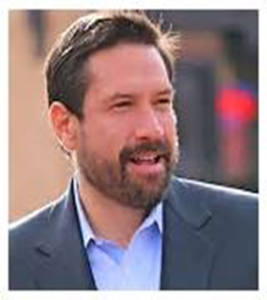
- A number of our students recently attended the Southwest Branch of the International Dyslexia (SWIDA) Conference in Albuquerque. Our students are associated with the NMHU PREP project, which is a partnership between HU and the Albuquerque Public Schools. The students all seek to become master level teachers in special education. A photo of our students and HU faculty:
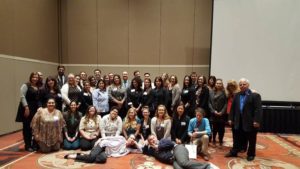
- We have a few more weeks to go in this year’s legislative session and both the House and the Senate will apparently recommend some tax increases to build up the state’s reserves. If those increases do not make it to the Governor’s desk or are vetoed when they get there, there will be little to do except make more cuts. The latest on all this: https://www.abqjournal.com/959477/senate-panel-oks-bill-to-raise-gas-vehicle-taxes.html.
- I encourage the faculty and staff to start the conversation about possible participation in the 2017 Homecoming. Ms. Juli Salmon is leading a group to make plans for this year’s event and it would be great to have more faculty and staff participation in this year’s Homecoming. As you may know, we now have an Alumni Board and that group, among others, is assisting Juli with the plans. They are very excited about some changes at HU and seem more than eager to get more engaged in things. At Department meetings, College meetings, etc., I encourage you to make some plans for this year’s event. Some things I’ve seen on other campuses—during Homecoming, (1) invite an alum or two to give a lecture to a class in her or his discipline, (2) attend a Homecoming event as a discipline/unit and make certain people know you are there and support alma mater, (3) sponsor a disciplinary reception and have faculty, staff, and students there, and or (4) ask a few successful alums to do a panel focusing on career advice, networking, etc. I am sure you all have more and better ideas and I also know that we have done some of these things here. My bottom line—we have put quite a bit of time and energy into alumni affairs and our annual Homecoming is probably the high point for many of our alums. Let’s make it a good as we can. You can contact Juli atjsalmon@nmhu.edu.
- The Leadership Team (including the deans) met on Thursday and we began the meeting with a discussion of a management and budgeting approach called Responsibility-Centered Management (RCM, go to: https://higheredtoday.org/2016/11/14/budgeting-institutional-success/). RCM is not really new. I have worked in such a system twice in my career and it is employed in a fair number of institutions of higher education. Sometimes this approach is called “every tub on its own bottom” meaning that each unit—say each college or school, perhaps even each department—is responsible for its own costs and revenue. I was a dean at a school, employing an RCM approach and each year I received a budget from the central administration and essentially told to manage it as best I could to deliver on our teaching, research, and service missions. Those in each unit were responsible for managing things. I had to live within my budget each year. If I went over, I simply had to find a way to cover the excess and if the unit brought in more than was budgeted, we got to keep some of that for reinvestment. Examples—if a Full Professor retired or left, I had full autonomy to hire two full-time temps if the budget permitted. I really didn’t have to seek approval to do that from anyone at all. It was up to me and my colleagues in the college. If we decided to launch a major online push and brought in tuition dollars in excess of cost, we could use that as we elected—more travel, more research dollars, more whatever. We were quite literally on our “own bottom” and it was up to me and the others in the college to make it work. If we went over—there was no bailout from my boss…the provost or the CFO. The approach we’ve used thus far at HU is clearly not a RCM type approach. A relevant question is—should we move toward this? A blurb from the article:
“Significant authority for managing the academic enterprise is shifted to deans and other academic unit leaders at RCM institutions. As such, academic heads with an entrepreneurial mindset can flourish in these environments. While some higher education traditionalists remain averse to this distributed leadership approach, most campus leaders who have implemented a version of RCM report that it empowers unit leaders to grow revenue and control costs. Another commonly seen effect of converting from an incremental model to RCM is increased transparency at the local level. While the cross-subsidization of institutional activities is as old as higher education itself, RCM models encourage academic unit leaders to track the cross-subsidizations within their area. For example, it would be expected that a unit leader would learn if a particular program is functioning far differently than its affiliated programs. Individual academic leaders would draw varying conclusions about the outlier program, and what, if any, action to take. All of this hinges on noticing the outlier, and credit for recognizing the uniqueness of the program goes to the underlying incentives of the RCM approach.”
Here’s what my experience suggests—nearly everyone thinks this is a great idea—on the front end. More autonomy. More discretion in one’s budget. No “Mother May I” type requests. And with the right management and leadership, it can really be a good thing. But…there are almost always problems as well. Let’s say one unit is successful and brings in significant dollars in excess of costs and then decides to provide more research funding to the folks in that unit…more than others receive. I’ve seen some pretty good fights around that. Or, instead of research funding, the unit decides to hire more staff help…again, more than in other units. Again, that can be a problem for some individuals. What happens if the campus is unionized and one unit decides to provide more travel support than another. That can be handled—even in a union situation—but sometimes it is difficult. And finally and most critically, what if the unit overspends and there is no central administration to the rescue? That’s where the “Responsibility” in Responsibility-Centered Management comes in. Chairs have to look their colleagues in the eyes when they make departmental cuts to cover deficits. Dean have to look chairs in the eyes. No more, “heh, we went $500 over on that trip.” OK…cover it. No more, “We are over on our equipment budget.” OK…cover it. If you overspend, the unit has to cover it—someway and somehow. I’ve seen some people long for the good old days when someone else could be on the hook for the overage. In some , but not all cases….managers and leaders prefer to criticize others for saying no to budget requests than taking responsibility for doing that themselves. I actually know several department heads and deans who resigned after RCM was rolled out and I thought they were really pretty good at their jobs. However, they simply did not like conflict and did not want to say no to their colleagues. So—I ask you….is RCM a good choice for HU? If so, how should it be rolled out? Incrementally? In one big bite? Not at all?
The remainder of the meeting was devoted to facilities issues, the potential provision of a space for DACA students, budget matters, and the upcoming 360 Review for HU executives and others.
- Our recruitment team was in Chicago this week visiting with hundreds of prospective students. The trip was facilitated by Mr. John Byrne. The rationale for recruiting there is twofold—(1) the out-of-state tuition those students would pay to attend HU is less than the in-state rates they would pay to remain in Illinois and of course, (2) the Chicago students would receive a high quality education here at HU, which would undoubtedly make a huge differences in their lives. The rationale for more out-of-state recruiting—the population in New Mexico generally is flat and in Northern New Mexico, it is declining. If we are to increase enrollment, we must put more energy into out-of-state recruiting. Otherwise, HU will shrink. Two photos from the visit—the top photo is our recruitment team with Mr. Byrne and the second a photo depicts Coach Fine with five young men already committed to HU. The photo is from Wendell Phillips High School, the oldest African American High School in the City of Big Shoulders. I should also point out the Wendell Phillips High School clothing on some of the students. In recent years, Wendell Phillips has been one of the top high schools (academically and athletically) in Illinois.
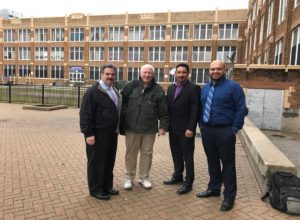
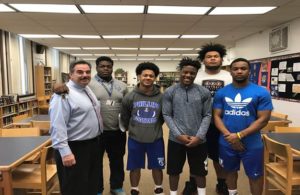
Speaking of recruitment, our office of SEM has totally redone the “welcome to HU” letter we send to admitted students. In the past, we basically send them a one-page business type letter saying they were admitted and next steps. Not very interesting. Now, we send them a packet of materials including a welcome letter, a large HU poster highlighting opportunities on campus, an HU pennant, and other items. A much better welcome to HU, in my view. Many thanks to Ms. Jessica Jaramillo and her team, Mr. Sean Weaver, and everyone who put this together. The front of the new poster: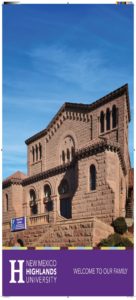
- This Week in HLC Accreditation (from Dr. Kempner): Our HLC Workgroups, tasked with writing the Assurance argument, began meeting this week, with Workgroups #4 and #5 meeting on Monday 2/27, Workgroup #1 on Wednesday 3/1, with the rest of the Workgroups scheduled for the meeting next week. You can see the Workgroup memberships at http://www.nmhu.edu/accreditation-information/accreditation-process/ . 1 to 2 members from each of the Workgroups have been assigned to one of our accreditation sub-criteria, and will work on drafting the 2-3 pages demonstrating that we meet that criteria. The entire Workgroup will review and edit the document, and then we’ll be sharing it with the entire campus community for input and comment. On other fronts, our curricular and co-curricular assessment are being completed for 2015-2016, with the curricular programs submitting their final reports this week and the co-curricular programs (like FYE, academic advising, ARMAS, the writing center, etc.) submitting their plans and learning outcomes this week. Also, on Thursday, we held a campus wide budget meeting where the President discussed his priorities for new expenditures.

Have a nice weekend colleagues.
Sam Minner,
President
Greetings colleagues. A brief update for the week of February 20-24:
- I sincerely thank the faculty, staff, and students who planned and participated in the Seeing in 3D event last Thursday afternoon. Mr. Eric Romero, Dr. Rebecca Moore, Dr. Carol Linder, and Dr. Peter Linder (and others) were all instrumental in planning this event and of course, several HU students made the event particularly meaningful. There is always room for improvement on each and every campus, but I must say that I was struck by the common themes running through the narratives of the students—I came to HU not certain about how I would be treated, if I would be welcomed, etc. and I found an inclusive and very welcoming community. Again, I know we can do better than we are doing with all this, but still…the student messages were very affirming. Thanks to all who made this happen.
- Friday was HU Day at the Roundhouse and we had a very good showing. I heard many positive comments about the event. We filled the rotunda with our banners and flags. We set up several tables with HU giveaways and information about current campus happenings. At noon, several HU musicians performed and in the morning, a Memorial was read in the Senate and the House highlighting the many accomplishments of Chairman Leveo Sanchez, Dick Greene’s Jefferson Fellowship award, and the many accomplishments of our wonderful Vatos. Numerous Senators and members of the House praised Mr. Sanchez, Dr. Greene, the Vatos, and the long and distinguished history of HU. It was a great day. Many thanks to the individuals who made this happen: Dr. and Mrs. Joe McCaffrey, Senator Pete Campos, Representative Tomas Salazar, Max Baca, VP Law and her team, Dr. Warren Lail, the good folks at ARMAS, individuals from the HEC in Santa Fe, and many others. A small group of HU students also drove down and circulated around the Roundhouse advocating for HU and higher ed generally. A few photos from the various events:
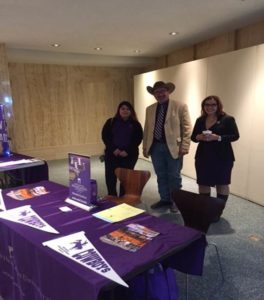
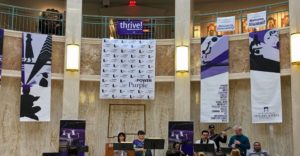
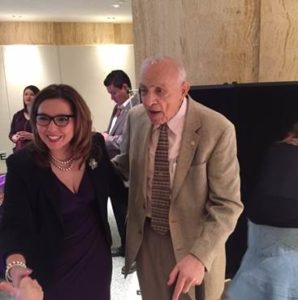
- Also last Friday, I met with the HU Alumni Board. I provided them with an overview of campus developments and we also covered a number of agenda items including fundraising, tailgating, etc. It is so great to have a formal voice for our alums. For me, it is impossible to shape policies on the basis of the random email, phone call, or Facebook posting. Now, an official group plays that role and alums have a conduit to express their interests and needs. Many thanks to VP Law and Ms. Juli Salman for their leadership with this group. After the meeting, there was a very nice and well attended alumni event in Santa Fe. A photo from that event:

- Campus life activities continue to perform well. About 250 people attended the Rhythm Of The Dance concert last weekend. We sold a number of tickets to the general public and those dollars will be added to the budget to support more student life activities. Also last weekend, about 40 HU students participated in another ski trip to Sipapu.
- Last Thursday-Saturday, several HU faculty, students, and former students participated in the USDA Conference in Albuquerque. HU co-hosted this meeting and by all measures, the HU contingent demonstrated great leadership, high participation, and consummate professionalism. Many thanks to Dr. Jennifer Lindline, Dr. Edward Martinez, and all the other HU folks who made this happen and made the meeting a success. A photo of some of the HU group:
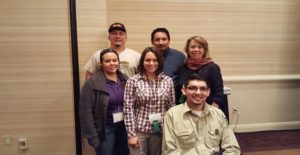
- Legislators are getting closer to finalizing a final appropriations bill. Apparently, the bill with the most steam is HB2, which relies on an estimate of roughly $218mil to balance the budget. The bill would cut higher education another 1%. That would mean over FY16, FY17, and FY18, higher education in New Mexico will be cut a total of 8.3%. I should note that higher education is 12.9% of the state’s budget, but took 38.9% of the cut from the state’s general fund budget. Things change daily in Santa Fe, but as of the writing of this week’s message, it does not appear that the Governor will accept HB2. A spokesman for the Governor referred to this budget as “political play” and disconnected from New Mexico values. If the additional revenues are stripped out of the Bill, there is really no alternative than to make deeper cuts—somewhere. If that scenario does indeed play out, it is likely to mean more cuts for higher education this coming year. I won’t speculate as to how deep those cuts may be, but they could certainly be substantial. Of relevance to this matter and also related to item #7 (below), I think the best overall summary of fiscal challenges in higher education is the Recession Reality blog, which I consult on a daily basis. Be warned—it can be unpleasant reading: http://recessionreality.blogspot.com/.
- Speaking of cuts—and does that topic ever not come up these days?—I was struck by a piece in Inside Higher Education titled Changing The Subject by Matt Reed. For the entire article go to: https://www.insidehighered.com/blogs/confessions-community-college-dean/changing-subject?utm_source=Inside+Higher+Ed&utm_campaign=d79f4c91fc-DNU20170221&utm_medium=email&utm_term=0_1fcbc04421-d79f4c91fc-198622925&mc_cid=d79f4c91fc&mc_eid=1b6e1fa6ce. In that article, Reed argues that the constant and never-ending calls for more cuts and more austerity simply grind people down. Speaking (or writing) only for myself, if I hear one more person assert that higher ed simply has to do “more with less”, I hope I am not holding a sharp object because I could lose control and lash out. As Reed put it, “The story of financial decline is compelling because it’s both relevant and true. It explains a lot of what we see every day.” And the reasons for the austerity we experience on a daily basis are also pretty clear. He states, “As a sector, we’ve become incredibly good at telling the story of financial decline. Nearly everyone can point to the disconnect between flat or declining public funding and increased costs. The more sophisticated like to add the exponential increase over time in health insurance. For extra credit, I like to throw in Baumol’s Cost Disease, which I remain convinced underlies the whole thing. Finally, you have IT, unfunded mandates, textbook publishers, and whatever else you think adds flavor.” True or valid as all that might be, it still sucks the air right out of the room. People are weary of austerity. Very weary. What to do? Well…he advocates an idea popularized by the late philosopher Richard Rorty who felt that breakthroughs in science, in politics, in economics, in whatever discipline often occurred not when someone solved some huge problem, but when smart people simply changed the subject altogether. It is a kind of interesting approach. Professor Rorty suggested that when this approach was used, the old questions didn’t really go away, but they stopped mattering quite so much and that paved the way for some new thinking. Are what have become the old narratives in higher education (declining state support, increased tuition, spiraling health care costs, blah, blah, blah) true, but….no longer really relevant in regard to any reasonable path to improving the situation? So…what would changing the discussion look like in higher education and at HU? Reed offers some suggestions: “It’s much more gratifying, and empowering, to focus instead on things we can do to turn it around. Given demographic headwinds — that is, declining numbers of 18 year olds — we can focus on doing things differently to keep more of the students we do get until graduation. That might include attacking “summer melt,” or developing competency-based programs, or looking at different configurations of the academic calendar. It might mean looking at peer mentoring, or finding ways to get peer mentoring into the online programs…It might mean any number of things.” My question—what would HU look like if we truly changed the questions and focused much more on things we had some chance of doing something about? Say, completion? Say, doing everything possible to make certain all of our students wind up with a good first-destination job and a good lifelong career? For example, what are we doing on competency-based programs? What are we doing in regard to credit for life experience? Is the old fall term, spring term, and maybe something in the summer approach really in tune with the needs of our students? The bottom line—forget about the old challenges (real as they may be) and just move forward assuming that everyone will continue to get less from state government and most schools will experience diminished enrollment. We have the resources we have the and the students we have….so what might we do with all that to improve outcomes? In a nutshell, that is what Rorty is suggesting.
My colleagues, I ask you—should we change the questions we ask and then push hard on possible solutions to them? Doing so would require major changes in thinking and action. As a practical matter, is that likely or even possible? Behaving this way, in my mind, does provide agency—we might move forward on things we have at least some control over. Sometimes when I think about declining state support, the resultant increased tuition, etc. I have deep doubts about my individual and even our collective ability to really do much of anything about those things. Sometimes it feels that I and we are working hard to maintain a fiscal structure that is simply no longer in place and unlikely to return. I advocate for our position as I can, I talk to people, I strategize, but in the end…it mostly seems to have minimal impact. In a way, this is all pretty complex, but in another way it is not. As state support goes down—tuition tends to go up in order to meet the requirements of our budget. We spend hours and hours talking about what we could or might do to “cut” even more, but frankly, those decisions usually are short-term fixes, if they are fixes at all, and at some point, there are really no more cuts to be made and still maintain operations. I am not suggesting that it is not important to constantly be on the lookout for efficiencies—I spend a lot of time on that each week— but making cuts in our work is also very difficult. It may not be all that complex, but it is tough. I say it is not all that complicated because at most colleges and universities, that vast majority of the budget is taken up with personnel costs—salary and benefits. If deep cuts have to be made, that amounts to “cutting” people and even that is done pretty much the same way at every school. Reducing budgets at universities has been studied and the processes and even the results are very similar across the sector. First, budget reserves (if a school has any) are tapped to get through the tough times. Then, vacant lines are not filled before someone with a real job loses it. In the end, most schools handle things that way. If even deeper cuts have to be made and people don’t simply evenly cut across the board, different programs are carefully examined and some of them are diminished or eliminated altogether. On most campuses, those discussion are very difficult and can be mean-spirited (my program is more critical than that program), but once again if truth is told, most schools pretty much wind up in the same place. If we are talking about academic programs, instrumental/professional programs are more commonly spared and these days, the traditional liberal arts and sciences, particularly the humanities, are scrutinized more carefully. I am certainly not saying I support that kind of approach or outcome, but I do know that is how things often turn out. It is a sad commentary on the academy, but all too real as you know. My bottom line—cuts do not solve fundamental and structural funding problems. In many cases, wiggle language like “right sizing”, “reallocating to build on strengths”, and the like really amount to simply cutting the way I described often resulting in a weaker institution.
What if I (and we) just accepted that we are likely to receive less state support and we’ll shift our thinking a bit and do a much better job with the students we have? Much better. I welcome your thoughts.
Some discussions continue in Santa Fe regarding the possibility of mergers of institutions of higher ed. . At this point, there is some talk of “studying” this issue and little else. However, mergers are very much in fashion across the nation. There is probably no better poster child for mergers that Georgia which has gone from 35 institutions of higher education to 29 and probably more mergers on the way. The most recent merger has been to combine Georgia State ( a research intensive university) with Georgia Perimeter (basically, a community college). Two relevant facts about Georgia—it is one of the best performing states in regard to increasing graduation rates and of particular interest, there is a single board governing higher education in the state. I state those facts not to endorse the Georgia approach, but simply to provide some additional background as to what is happening there. Other states in addition to Georgia are also looking at mergers (go to: http://www.deseretnews.com/article/865673728/Higher-education-innovation.html).
- Many thanks to all those who attended the kickoff-event to write the HLC Assurance Argument. About 35 people attended that event at noon on Monday. Also—many thanks to Sodexho for serving a very nice lunch. Sodexho is really doing a great job. Later that same day, we held another HLC forum. That forum focused on student retention and we had good attendance at that meeting as well.
- We continue to work as we can to make the campus more welcoming to everyone, particularly families. Toward that end, I am pleased to announce that baby-changing tables have been installed in Wilson, the first floor restroom in the library, in Felix Martinez, and in the SUB. I think I mentioned that I saw a dad changing a baby in Wilson the other day—on the yucky floor. Surely we can do better than that. Thanks to Sylvia Baca and the facilities crew for getting this done.
- A major push out to recruit more students is now underway. We will soon email about 20,000 student whose names we have purchased and another 7,500 students who have contacted us directly. We’ll also contact another 22,000 students who are considered underserved by the ACT (we don’t have to pay for those names, but in truth, many schools get those names and contact those students). Each student will receive up to nine email outreaches about HU. Dependent on their responses to our emails, some will also receive hard copy materials and some will receive phone calls. In addition to this effort, our recruitment office continues to blanket the high schools and community colleges in New Mexico. I will be visiting a number of high schools with our recruiters. An event recruiting prospective STEM students is planned on the Rio Mora Refuge. I have previously shared a sampling of our new recruitment materials including materials in English, Spanish, and Navajo. We are also working much harder than we have in the past to recruit out of state students. For example, next week, Dr. Martinez and other staff members will be in Chicago recruiting at several high schools including one serving predominantly Hispanic students. A relatively small number of students coming to HU and paying out of state tuition can make a huge difference in our revenue stream. Plus, having students from different parts of the country also adds another dimension to our student diversity, which is nice. We’ll emphasize that a high quality HU education is more affordable to the students from Chicago than going somewhere in-state (which is true). Other features of an HU education—small classes, high-impact learning, easy access to great outdoor activities, top-notch professors, a vibrant campus life, etc.—will also be discussed. We anticipate that the HU message will be delivered to several hundred prospects in the Chicago area. We owe a debt to Mr. John Byrne who is opening doors for us in Chicago. In another recruitment/retention development, our Office of Strategic Enrollment Management—I think for the first time—is completing a study examining financial aid leveraging. In the past, we simply awarded whatever scholarship dollars we had, basically on a first-come first-served basis. Believe me, you get no leveraging from that at all. Now we know, for example, how many first-time full-time freshmen students we support with some scholarship actually complete and graduate compared to say, what happens when we award a scholarship to a transfer student. We now have at least some of those data and can make much more strategic decisions about how to use the precious scholarship dollars we have. What type of student should we support to maximize completion? We now have some answers. Finally, we are taking a good analytical look at HU students who are close to graduating, but owe us a small amount of money. Just one example—we have identified one student who needs six hours to graduate with a University Studies degree, but also owes us some money—$30.00 to be exact. This student is not in school now and as I wrote, needs only six more hours to graduate. We are working on a process to help convince that individual and similar students to finish up. One might assert that surely the $30.00 debt that person owes cannot be keeping this person from enrolling and finishing up, but there were certainly times in my life when I didn’t have thirty dollars. So, maybe that is a real challenge for the person and maybe we can…and should…do something about that.
- On Wednesday, I attended the first meeting of the City of Las Vegas Housing Advisory Committee. As a member of that group, I provided an HU perspective on housing issues, challenges, and possible remedies. There were lots of interesting points made at the meeting ranging from the lack of new housing starts in Las Vegas, weak enforcement of statutes involving care of lawns and residential facades, possible inflation of housing costs in Las Vegas due to a limited inventory of houses available for purchase, and many others. Individuals from numerous local/regional agencies and realtors attended the meeting and made some very good points. Later on Wednesday afternoon, Joan and I drove to Santa Fe to attend the City of Las Vegas event for legislators (e.g., Las Vegas Day). The event, held at La Fonda, was very well planned and executed. The event attracted a nice crowd. HU partnered with the City of Las Vegas and other agencies to help make this event a success. Many thanks to the HU folks who could attend that event.
- Early Thursday morning (very early), I participated in the monthly RMAC conference call and as is always the case, lots of things are perking with RMAC and the NCAA generally ranging rom a concussion lawsuit to a discussion of two-a-days prior to the football season to other matters both weighty and light. I should note that Dr. Heather Wilson, an RMAC leader in so many ways and President of South Dakota School of Mines, has been nominated as the Secretary of the United States Air Force in the new Trump administration. She is awaiting confirmation. I enjoyed working with Heather very much and she will be missed in the RMAC. Some of you may know her as she has a New Mexico connection. She previously served in Congress representing the 1st Congressional District of New Mexico.
- Over my career, I’ve written several short pieces about starting a new job or leaving an old one and I just had another one accepted. It will soon be published in an online source. This one’s about “early visitors” and is attached above. It is a little tongue in cheek, but it does represent my experience with early visitors.
- From Dr.Kempner: This Week in Accreditation: On Monday 2/20, we held a kick-off luncheon for the Assurance Argument volunteers. This group of 50 faculty, staff, and student volunteers will be writing the 100 page document we provide to the HLC, proving that we meet all accreditation criteria and have resolved all the probation areas. The volunteers are divided into 6 teams, with 5 teams focus on one of the 5 main accreditation criteria and the other working to organize our site visit. Our initial draft will be completed by May, then data added over the Summer, with a full version provided to the campus community by September 1 for comment and review. Also on Monday 2/20, we held a forum on the retention initiatives currently underway on campus. If you were not able to attend, the forum recording is available at http://www.nmhu.edu/accreditation-information/forums/, along with all our past HLC forums.

Have a great weekend my colleagues.
Sam Minner,
President
Greetings colleagues. A brief update for the week of February 13-17:
- Congratulations and many thanks to Mike Petronis, Jennifer Lindline, and Kerry Loewen for winning an NSF grant to support the participation of HU students and faculty in research opportunities in the Czech Republic. Geology and Media Arts students will work with Mike and others on several geology projects. This nearly $300K project will support the research activity of at least 15 HU students over three years. These are exactly the kinds of experiences that are transformative for our students. Those experiences change their lives…forever. Well done, well done, well done. Congratulations are also due to Dr. Virginia Padilla-Vigil. One of her online courses was recently certified by Quality Matters (QM)…in my mind, the premiere professional organization certifying online classes as truly excellent. We used QM at Radford University and I know that most courses that go before QM are not approved…at least the first time. Here’s the QM site if you care to read more: https://www.qualitymatters.org/. Well done! Here’s also a couple of papers Virginia published on online learning: https://vpadillavigil.wordpress.com/different-but-definitely-doable-deconstructing-the-myths-about-online-learning/ andhttps://vpadillavigil.wordpress.com/2014/07/. As you can see, we have a resident expert on online matters right here is our midst.
- The Highlands Loves Alumni event was a great success (last Thursday evening) and in addition to “showing the love” for our alums, we accrued more than $3,000 for the Home Field Advantage campaign. The HU Advancement Office is performing very well, in my view. Our alumni events, like the Highlands Loves Alumni event, are well attended and very well organized. Advancement operations like the Annual Fund, the Home Field Advantage, etc. are well planned and once again, performing well. That major reengineering began in 2015 and we have demonstrated a nice steady and positive trend line since that time. In 2015, we accrued $626,453 (restricted and unrestricted funds). In FY 2016, we brought in $723,469 (a 15% increase) and thus far in FY 2017 (with 5 months remaining) we are at $702,007. There is no way to know for certain where we’ll end up this year, but if we remain on the same pace, we’ll accrue nearly $1mil by the end of this fiscal year (again, restricted and unrestricted). This bodes well for us. A photo from the Highlands Loves Alumni event—hard to say if the guy in the middle is smiling for the camera or poking fun at the goofy guy on the right:

- On Monday morning I welcomed a group of about 50 students from West Las Vegas to HU and told them all about the many advantages of an HU education—great value (a combination of quality and cost), a focus on learning and their own intellectual development, and a vibrant campus life. Thanks to Strategic Enrollment Management for arranging this visit. On Wednesday morning, I welcomed another enthusiastic and interested group of prospective students from Taos. Our Career Services office also welcomed the Taos students to campus and I thank them for it. A photo of the West Las Vegas group. I asked the students to “look” interested. I’d say some followed my instructions…some perhaps not so much:
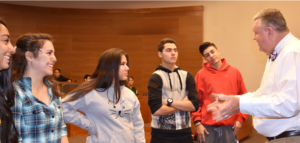
- Over the weekend, U.S. News and World Report published their list of schools with the least expensive out-of-state tuition. HU ranked #8 on that national list. That bodes well for us, but it does little or nothing for us unless we aggressively pursue more out of state students. We are doing that. We recently recruited in Montana and will soon be doing a major recruitment trip to Illinois with more to come. The top 8 schools according to U.S. News:

I.Alcorn State University (MS) $6,552
I.I.Minot State University (ND) $6,568
III. Gordon State College (GA) $6,761
IV. University of Texas of the Permian Basin $7,866
V. Central State University (OH) $8,096
VI. Southwest Minnesota State University $8,336
VII. Bemidji State University (MN) $8,386
VIII. New Mexico Highlands University $8,650
We must do more to take advantage of our recent rankings for affordability and student outcomes—most affordable four-year university in New Mexico, third most affordable four-year university in the Southwest, 8th most affordable university for out-of-state students in the nation, second highest annual earnings by graduates in New Mexico (New Mexico Tech ranked #1), and least debt by graduates of any university in new Mexico.
- It was another busy week in Santa Fe. On Monday, I met at the Higher Ed Center with the Finance Committee of the Foundation and had another meeting with Dean Duran and others. Dean Duran is doing such a great job…taking on challenges in stride and with good cheer. I returned to Santa Fe on Tuesday to have an early breakfast with other university presidents and members of the House Finance Committee. Later that day, the Council of University Presidents (CUP) met in preparation for the House Finance Committee meeting at 1:30. At that meeting, Chancellor Carruthers (NMSU Chancellor and President of CUP) made a presentation on behalf of all CUP members. Secretary Barbara Damron also made a presentation to the committee (attached above). The committee asked Max to return on Wednesday to provide some details regarding the CFI requirements (that pertains to the overall fiscal health of an institution and is one of the HLC standards) and I will return to Santa Fe once more on Friday for HU Day @ the Legislature and variety of meetings and activities including a meeting with the newly established Alumni Board. Overall, a busy week in Santa Fe. In regard to the state budget (and implications for us), the budget deficit that must be addressed next year is estimated to be about $125mil. Max and I hear that the cut to state agencies (including higher ed) could be 2% or more, but nothing is really set at this point. A huge sticking point is the possibility of new revenues. Some officials assert that we must bring in more revenue. Others advocate for even more belt tightening. As you might guess, some fall somewhere in-between. A brief update about the state’s budget:
SANTA FE — A dire forecast for state government revenues in the coming fiscal year remains unchanged after a review by a group of state economists that sets parameters for government spending, a top budget negotiator in the House of Representatives said Wednesday.
House Appropriations and Finance Committee Chairwoman Patricia Lundstrom told the Associated Press that economists projected a small uptick in expectations for oil-sector income that was offset by decreases in other tax revenue. The “flat” forecast means that lawmakers are confronting a $125 million shortfall in order to maintain government services and spending commitments to schools and local governments, she said.
The Democrat from Gallup says closing the looming budget gap would require an additional 2 percent overall cut to agency spending if no new taxes or other revenues are approved for the budget year starting July 1, citing an analysis by appropriations committee staff.
“We’ve just seen from the revenue projection that we’re not getting any more from our traditional sources” of income, Lundstrom said. “I want to be able to put this budget on the floor (of the Legislature) with at least another $125 million to cover costs.”
The state has been struggling to pay its bills and sustain basic government programs amid plunging tax revenues tied to a downturn in the oil sector and a sluggish overall economy.
A package of solvency bills adopted last month plugged a current-year budget deficit and restored a modest financial cushion by sweeping cash from school district reserves and other government accounts. Spending across state agencies was slashed by 2.4 percent during a special legislative session in October, with annual reductions of 8 percent at some departments.
Leaders in the state’s Democratically controlled Legislature and Republican Gov. Susana Martinez also are seeking to boost reserves to protect the state’s credit rating and borrowing costs, but still differ on how to obtain those funds.
“We need another $100 million for the reserves,” Lundstrom said. “What we’re trying to do is avoid another downgrade in our bond rating.”
Martinez has steadfastly opposed tax increases and called for further belt tightening by state government, but also indicated she may be open to closing tax loopholes.
Lawmakers on the House appropriations committee are considering revenue-raising proposals that would tax nonprofit hospitals, tax online sales by out-of-state retailers such as Amazon and restore the sales-style gross receipts tax on medical services.
The state’s budget crisis has taken a toll on host of government services, from public defenders who have denied counsel to poor defendants to state museums that have cut back hours and increased admission prices.
While in Santa Fe, I also received a briefing from the State Land Office. HU is a State Land Trust beneficiary and we receive some support from that trust each year. A photo of me with the Commissioner, Mr. Aubrey Dunn: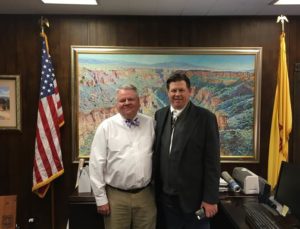
- One things we can do to conserve our resources (fiscal and natural) is to work hard to reduce our water, gas, and other usage. Our Facilities Department and many other individuals and groups have been working hard on this and I am very pleased to announce that we have expended $61,726 less this year than at the same time last year. That is an 11% decrease. Well done to all who care about our finances and our planet.
- Joan and I joined a very nice crowd at Ilfeld Auditorium on Wednesday evening to see the Rhythm Of The Dance performance. The National Dance Company of Ireland put on a great show with rousing dance, song, and instrumental performances. It was really a great evening. We are very close to signing the contract with the spring music acts. We really can’t make an announcement about the headliner until we have a signed deal, but I will say this—the performer was nominated for a Grammy the other night. He didn’t win, but he was nominated. A photo of the Irish dance troupe performing in Ilfeld:
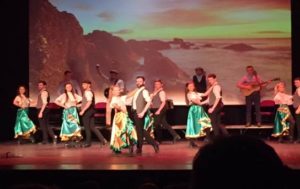
- On Thursday, we held the Executive Leadership team meeting and opened with a brief discussion of an article from the Corner Office, which appeared in the Sunday Times. Here’s the article: https://www.nytimes.com/2017/02/10/business/todd-rovak-corner-office-capgemini.html?rref=collection%2Fcolumn%2Fcorner-office&action=click&contentCollection=business®ion=rank&module=package&version=highlights&contentPlacement=1&pgtype=collection&_r=0. The author, Todd Rovak, talked a bit about some managers who see others as mostly a means to help them advance their careers and what he called dark meetings—meetings where the focus is on dealing with problems and making hard decisions. Rovak asserted that many meetings (most?) in complex organizations are rather “dark” and things worked better for him when he just accepted that and did the best he could with it. Basically, he was much happier and more successful when he understood and accepted the fact that his “job” as leader was to solve problems…not just come into the office and give or get high-fives. Most people like doing that, of course, but good leadership and management is about much more than that. It was a good and honest discussion, which I appreciated. Provost Roxanne Gonzales joined the meeting via Skype and we also welcomed Dr. Mike Petronis who we congratulated on his new grant (see #1 above). We also talked about encouraging our students to participate in the next Domenici Institute. Interim Provost Linder will be leading the efforts to get that done. For more on the Institute and the opportunity some of our students may have, go to: http://domenici.nmsu.edu/. We also discussed and took some actions on a number of housekeeping matters including the campus master plan, the emergency operations manual, commencement, HU Day @ The Legislature, and other matters.
- The weekly HLC update—Many thanks to all the faculty and staff who volunteered to participate in one of the workgroups preparing our assurance argument for the HLC. There will be a luncheon for these individuals on Monday, February 20 from 12-1 in the SUB Ballroom. I will make a few comments and Dr. Kempner will talk a bit about the process for preparing the argument. We are getting an early start on the document, which is good. The goal—a rock solid assurance argument prepared well in advance of the due date with ample time for review and revisions (as necessary) by the faculty, staff, administration, and the Regents. Our Vision, Mission, and Goals:

Have a great weekend my colleagues.
Sam Minner,
President
Greeting colleagues. A brief update for the week of February 6-February 10:
- The Board of Regents met on Friday and heard various reports and acted on numerous proposals. Several students attended to promote the Safe Campus concept to the regents and administration. This is a challenging time for many of our students – DACA, LGBTQ and others – and the board and administration share their concern. I’ve said this before, but it bears repeating: At Highlands, we don’t care where you’re from or who you are. You’re part of our family and will continue to be so. Period. The board members expressed their support along with the faculty, staff and student senates. I’m looking forward to talking face-to-face with the students who very thoughtfully expressed their concerns. The Board adopted the new core branding policy. Professors Mariah Hausman and Angela Meron worked with Director of University Relations Sean Weaver to develop Highlands’ visual identity, and I would like to thank them for their continuing work on ensuring our materials maintain a professional and cohesive image for the university. The board and administration felt Mariah and Angela created a visual identity that represents the Highlands family, spirit, and our wonderful location in Northern New Mexico. The new branding and visual identity will allow the university to highlight our many strengths to a number of audiences in a unified, consistent manner. Sean will be meeting with deans, chairs and directors during the next couple months to discuss how the new branding impacts each unit. The board, at the suggestion of the Association of Governing Boards, introduced a new component to its meetings; extended discussions about specific programs at HU. The board heard great presentations by the School of Education’s Bilingual Program, the Spanish Program and the Facundo Valdez School of Social Work. Additionally, we had a brief discussion on the university’s budget priorities, which will be soon presented to the campus community, and a preliminary discussion on tuition. In other news, the board:
- approved a proposal for disposing of outdated library books,
- formally accepted FY16’s audit report, and
- and approved routine items ensuring the university’s financial compliance with New Mexico law.
- This weekend, College Scorecard (a program sponsored by the United States Department of Education), issued its annual findings regarding college costs and earnings of graduates. As one might imagine, graduates of New Mexico Tech earn more, on average, than graduates of any other public university in new Mexico. Graduates from Tech earn, on average, $54,300. Of course, engineers earn more than many other individuals these days so really no surprises there. I should also note that the average annual cost at Tech is $11,451. Take NM Tech out of the equation and things get interesting. Take a look:
institution average annual wage of graduates average annual costHighlands $35,200 $6,621UNM $34,900 $10,079NMSU $32,800 $9,531Western $31,300 $11,055Eastern $29,300 $10,090Northern $27,500 $9,268Source: collegescorecard.ed.govAs you can see, (taking Tech, which is a significant outlier, out of the equation), our graduates earn more on average than graduates from any other four year school and yet, we are the most affordable. For example, HU graduates earn more than $5,900 more than graduates of Eastern, but pay $3,469 less each year they are in school. Over four years, that’s $13,876 less. Our graduates earn $7,700 more each year than graduates of Northern, but pay $2,647 less each year—a $10,588 savings over four years. This is really a good news story for HU and we should all highlight these data when talking with prospective students. Here’s the headline:NMHU—Highest Average Earnings By Graduates (not counting Tech)/Lowest Cost Of AttendanceGREAT VALUE!!!!!!!!The College Scorecard also notes that the typical student debt for NMHU undergraduate students is $12,500, which is much lower than the national average. Higher average salary, lower average debt, and lower annual costs are all great reasons to encourage students to attend HU. And this does not even address the overall student satisfaction with the Highland’s Experience, which is high. This is good news for us, but like most other schools we have grappled with and continue to be challenged by demographic changes in the potential student pool. This from a recent report from Ruffalo Noel-Levitz:“Last month the Western Interstate Commission on Higher Education (WICHE) released updated high school graduate projections through 2032 . The report contained the following findings and observations:
- The steady growth in high school graduates that led to significant expansion of higher education in the United States in recent decades is coming to an abrupt halt. While the percentage of graduates grew 30 percent from 1995 to 2013, the number of high school graduates is expected to show virtually no growth for the next seven years.
- Dramatic increases in graduates who are Hispanic or Asian/Pacific Islander will continue. The racial/ethnic mix of high school graduates in the United States will shift significantly toward a more diverse population of graduates fueled primarily by large increases in the number of Hispanic (50 percent) and Asian/Pacific Islander (30 percent) public high school graduates through about 2025.
- Marked regional differences will continue as well. There is significant regional variation, with the Northeast and the Midwest experiencing continuing declines in the number of high school graduates, while the West will see slight increases and the South significant and steady increases. Most notably, the South is the engine of growth for high school graduates.
The enrollment challenges noted in these findings are probably not a surprise to most higher education leaders who are already feeling the impact of weakening student demand. Indeed total enrollment in degree-granting institutions declined by more than 800,000 students between fall 2010 and fall 2014 according to IPEDS. The National Student Clearinghouse, which produces data ahead of IPEDS, has now reported enrollment declines for ten consecutive terms through fall 2016.
It never ceases to amaze me how many higher education leaders, who are generally quite aware of these trends, continue to believe that these market forces do not apply to their own institution. I believe this results from a failure to localize these trends to their own student catchment areas and actually measure the probable impact on their future enrollment levels.
While it is easy to get discouraged by these market forces, at Ruffalo Noel Levitz we know that institutions that take a holistic approach and engage in a sustained strategic enrollment planning process are faring better than those who choose to ignore the realities of the current market.
In our view, strategies that improve market penetration (and this includes improved retention and graduation rates), need to be balanced with a mix of program and market development strategies to achieve optimal demand. Developing new academic and co-curricular programs along with addressing new geographic and demographic markets is essential for most institutions to meet these enrollment challenges and thrive in these uncertain times.”
Modern enrollment management dictates that successful institutions penetrate more deeply into existing markets and….seek out new markets that make sense for the school’s mission. We are doing both. The counselor’s workshop we held the other day and my own efforts to accompany our recruiters to local schools are examples of the former and our efforts to do more out-of-state recruiting are examples of the latter. Our recruitment team will soon make presentations about HU to hundreds of students in Chicago. We are recruiting more Native American students in Montana right now. A private school in the Midwest is closing and I have contacted the president there to see if the students have an interest in HU. The bottom line—you have to aggressively work your local and traditional markets and actively seek new markets where you have a chance of gaining some students.
- It was a busy weekend with lots of on campus activity. I welcomed the Amigos de Las Americas student group on Saturday. This is the second year we’ve hosted them on our campus. Many thanks to Professor Eric Romero for taking some of his precious Saturday to also work with the group. There were two very exciting basketball games on Saturday evening. It was right down to the wire in both games. Coach Fine and AD Clifford welcomed several potential recruits to our campus including a number of prospective student-athletes from New Mexico. Baseball season started in some fairly cold weather, but we start according to the schedule not the weather. About 50 of our students attended the Super Bowl watch party on Sunday and about 40 of our students participated in the formal British Tea event. Overall, a very busy, but very nice weekend.
- I hope members of the faculty consider applying for the President’s Leadership Development Fellowship Program (PLDP). The first Fellow, Dr. Jennifer Lindline, is completing her posting this spring term and a call for next year’s recipient went out a few days ago. In the event you missed it, it is attached (above).
The American Council on Education (ACE) recently published a review of their ACE Fellows Program (I’d say the premiere leadership development program in higher education) and offered several “key takeaways” from their program, which they have supported for fifty years. Their takeaways:
- leadership development programs should ideally benefit the individual, the institution, and the whole of higher education
- the program should promote internal succession planning
- the program should include diverse individuals
- when possible, programs should invest in individual and team leadership development
I am pleased to say that the President’s Fellows Program at least touches on these variables. I have supported leadership programs at several universities and the program was the first step for many great leaders now holding important and responsible positions at institutions throughout the country.
- VP Law and I were on KFUN radio on Monday morning talking about the football field campaign. Over the weekend, another $1000 commitment to the field came in and the major mailing for the campaign will be sent next week. The fund continues to grow and as I wrote, the major push is yet to come. Many thanks to VP Law and AD Clifford for all the time they are spending on this important initiative.
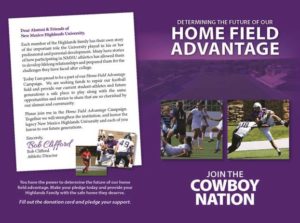
.
- I recently met with some representatives from HED about the possibility of establishing a GED/ HiSET Testing Center on our campus. The HiSET is an alternative to the GED. Apparently, there is no place near Las Vegas that does, thus making it hard for local residents to complete the exam. I will be moving ahead on this and we’ll establish a testing center on our campus.
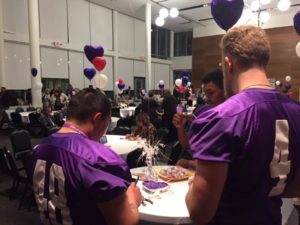
- Many thanks to all who attended the February Coffee with the President meeting on Wednesday morning. About 100 colleagues heard a brief report on campus activities and I reserved some time for questions. I certainly plan to continue these events, but I am also available and quite willing to come to other meetings—college-wide meetings., departmental meetings, etc. Just let me k now and I’ll work it into my schedule.
- The Highlands Loves Alumni event last night was absolutely wonderful. Great food, great music, and lots of alums and friends of HU. Many thanks to VP Law, Juli Salmon, and the whole team for a great job. A photo from the event:
- This Week in HLC Accreditation (an update from Dr. Kempner): The HLC has given us our dates for upcoming visit: Monday November 6, 2017 – Wednesday November 8, 2017. This earlier date will be excellent for us, as it avoids conflicts with Thanksgiving Break or Finals. A lively and involved campus will help us make the best possible case to the HLC. This means that we’ll need to have the Assurance Argument filed with the HLC by early October, and our goal will be to have a completed draft of the Assurance Argument ready for campus and Board of Regents review by September 1, 2017. That gives up roughly 6 months to write the best Assurance Argument possible. I have organized our 50 HLC volunteers into 6 groups, and we’ll kick off our writing once I get back from the HLC Professional Development Week conference next week.

Have a great weekend my colleagues.
Sam Minner,
President
Greetings colleagues. A brief update for the week of January 30-February 3.
- I spent a lot of time in Santa Fe this week doing my best to represent HU and make the best possible case for resources. On Tuesday, the Council of University Presidents (CUP) met and later that afternoon we made our presentation to the Senate Finance Committee at the Roundhouse. The PowerPoint presentation is attached (above). I would say the members of the committee seemed supportive of higher education, very aware of the role we play in the overall health of the state, and cognizant of the fact that we have taken recent cuts. However, higher education is one component of state government and as a state agency, I do anticipate additional rescissions. Secretary Barbara Damron hosted the university presidents at a social function in her home later that evening. Joan accompanied me to that event. On Thursday morning I attended another meeting in Santa Fe and Joan and I drove down (once again) in the afternoon to attend the annual Senate Finance Committee dinner. A photo from the Tuesday afternoon Finance Committee hearing:
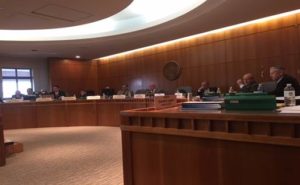
- Strategic Enrollment Management recently examined the cost of attendance in several of our key markets. We selected schools considered to be competitors for our prospective students. For states other than NM, we used our out-of-state tuition rate. If a community college competed for students potentially interested in HU, we included them on the list. Take a look:
School Location Tuition & Fees Room & Board Books & Supplies Other Total Estimate
NM SCHOOLS
New Mexico Highlands University Las Vegas, NM $5,400.00 $4,918.00 $1,860.00 $2,878.00 $15,056.00
University of New Mexico Albuquerque, NM $6,950.00 $9,472.00 $1,080.00 $3,858.00 $21,360.00
New Mexico State University Las Cruces, NM $6,729.00 $4,520.00 $1,620.00 $3,780.00 $16,649.00
Eastern New Mexico University ` Portales, NM $5,510.00 $6,760.00 $900.00 $3,505.00 $16,675.00
Western New Mexico University Silver City, NM $6,644.00 $8,936.00 $810.00 $2,060.00 $18,450.00
Central New Mexico Albuquerque, NM $1,340.00 $6,253.00 $1,368.00 $3,242.00 $12,203.00
Northern New Mexico College Espanola Valley, NM $5,112.00 $8,164.00 $1,200.00 $3,934.00 $18,410.00
*Information displayed in this document are subject to change at the discretion of the University. Information can be located on each website for up-to-date information.
CA SCHOOLS
New Mexico Highlands University Las Vegas, NM $8,500.00 $4,918.00 $1,100.00 $2,784.00 $17,302.00
California State University- Long Beach Long Beach, CA $6,460.00 $12,398.00 $1,898.00 $2,854.00 $23,610.00
Vanguard Univ. of Southern California Costa Mesa, CA $30,980.00 $9,310.00 $1,764.00 $3,170.00 $45,224.00
California State Univ. – Monterey Bay Seaside, CA, CA $6,227.00 $11,930.00 $1,311.00 $2,447.00 $21,915.00
California State Univ. – Los Angeles Los Angeles, CA $6,031.00 $12,860.00 $1,809.00 $2,721.00 $23,421.00
University of California, Berkeley Berkeley, CA $13,485.00 $15,115.00 $1,240.00 $5,132.00 $34,972.00
University of California, Los Angeles Los Angeles, CA $13,409.00 $15,069.00 $1,635.00 $2,277.00 $32,390.00
University of California, Irvine Irvine, CA $15,026.00 $13,661.00 $1,772.00 $2,960.00 $33,419.00
College of the Desert, California Palm Desert, CA $1,289.00 $12,492.00 $1,791.00 $2,916.00 $18,488.00
*Information displayed in this document are subject to change at the discretion of the University. Information can be located on each website for up-to-date information.
CO SCHOOLS
New Mexico Highlands University Las Vegas, NM $8,500.00 $4,918.00 $1,100.00 $2,784.00 $17,302.00
Fort Lewis College Durango, CO $8,105.00 $9,130.00 $1,208.00 $5,308.00 $23,751.00
Adams State University Alamosa, CO $9,009.00 $7,950.00 $1,350.00 $2,610.00 $20,919.00
University of Colorado, CS Colorado Springs, CO $9,863.00 $9,800.00 $1,800.00 $4,600.00 $26,063.00
Colorado College Colorado Springs, CO $50,892.00 $11,668.00 $1,248.00 $2,592.00 $66,400.00
Colorado School of Mines Golden, CO $17,842.00 $11,477.00 $1,500.00 $1,865.00 $32,684.00
Western State Colorado University Gunnison, CO $9,193.00 $9,446.00 $1,300.00 $2,763.00 $22,702.00
Community College of Denver Denver, CO $5,130.00 $9,072.00 $1,800.00 $4,986.00 $20,988.00
Colorado Christian University Lakewood, CO $29,360.00 $11,010.00 $1,200.00 $1,650.00 $43,220.00
Colorado State University-Pueblo Pueblo, CO $9,519.00 $9,910.00 $1,200.00 $3,556.00 $24,185.00
*Information displayed in this document are subject to change at the discretion of the University. Information can be located on each website for up-to-date information.
One thing to keep in mind about college costs and particularly, college debt, is that, in general, graduates with significant debts are usually not the real problem. The biggest college debt problems are from students who do not finish college and leave with debt and nothing more than a high school education. Many college debts are quite small and borne by students who did not finish. But, in many cases they cannot repay even those small loans given the relatively low-wage jobs they have after leaving university without a degree. In some cases, the college debt “problem” is less about how much money is owed and more (much more) about if the student actually finished university and the job she or he got after finishing. Paying back a $25,000 college debt on a decent salary is hard enough. Paying it back earning $10.00 an hour is virtually impossible. For example, go to: https://www.washingtonpost.com/news/grade-point/wp/2016/07/19/white-house-presents-a-more-nuanced-picture-of-student-debt/?tid=a_inl&utm_term=.3e24627a7df0.
So much has and continues to be written about affordability. It is sometimes difficult to sort it all out. But one issue is irrefutable—in most states, public funding for higher education lags pre-recession (2008) levels. When state support goes down and costs remain constant (or rise…increases in insurance, energy, employee compensation, etc. ), the money must come from somewhere. Consider this—in New Mexico, the decrease in per student funding from the recession to 2015 (the most current data available) is $4,383. I mean really…and people wonder why we are struggling with our budget? You can do the math, but for every 100 students that’s about 1/2mil dollars less. Serve 3000 students—that’s $13mil less—per year. Incredible.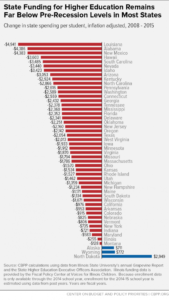
- Given my time in Santa Fe, we did not have a leadership team meeting this week, but I did distribute a brief reading to the team regarding civility—actually incivility—in the workplace. The paper focused on incivility particularly between and among faculty members (but I think the ideas could be applied in many contexts). At the heart of this paper is a tension I have seen played out many times at different institutions. Some schools devise a stand-alone policy focusing on collegiality and a few, including some where I’ve worked, actually include that variable in tenure, promotion, and other high stakes personnel decisions. That is, peers and others review materials of various sorts and then make a judgment about the applicant’s performance in teaching, scholarship, service, and…collegiality. In the case of the schools that do this, there is typically at least some attempt to define collegiality, but I must say that my own experience with that is that the definition is pretty weak and very open to interpretation. That approach is in contrast to schools that just leave that variable alone and indeed, are more in line with the AAUP approach, which asserts:
“Collegiality is not a distinct capacity to be assessed independently of the traditional triumvirate of teaching, scholarship, and service. It is rather a quality whose value is expressed in the successful execution of these three functions.” Furthermore, establishing a stand-alone criterion for collegiality, according to the AAUP, “…holds the potential of chilling faculty debate and discussion.”
How are things handled (or should be handled) on our campus? Do peers fold judgments about collegiality into tenure, promotion, and other personnel decisions? Does that come up when selecting a new colleague? If so, how is performance in that domain determined? Mere opinion…or something more? Are there guidelines or is it just off the cuff anecdotes? If that variable is not included, should it be?
Those are interesting questions and based upon my own experiences at different schools, I certainly have my own opinions about all this. I have worked in departments where one or more colleagues were distinctly uncollegial and really difficult to be around. Still, some of them were really great teacher-scholars—much better than me—and I respected them for their professional work even when I did not necessarily enjoy being around them. However, I’ve also worked in departments and or colleges where everyone got along wonderfully and, in some cases…it was basically dead. Nothing was moving forward. An intellectual wasteland. No one wanted to offend or even engage anyone else in a way that could even potentially result in even the mildest conflict. I could not wait to get out of that place.
Here’s the paper I distributed: https://www.insidehighered.com/news/2012/06/15/how-tackle-incivility-among-faculty-members. I’d welcome a dialogue about this. Just let me know.
- Various Campus Life initiatives continue to attract significant numbers of students. Last Saturday, HU sponsored a Welcome Back Dance at the Plaza Hotel Ballroom. Students paid nothing at the door of this event, which attracted 108 of our students. Also, by virtue of a grant from the New Mexico Office of Substance Abuse and Prevention, HU staff and students are going out into the community to talk about the dangers of providing alcohol to minors. A group of our students at a recent West Las Vegas basketball game:
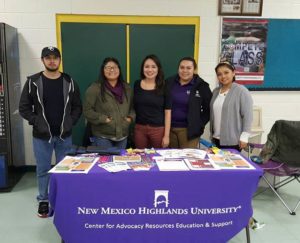
- This past weekend we hosted a number of Chicago Scholars. These young men and one woman toured the campus and Las Vegas and heard a number of presentations about what HU had to offer them. Joan and I joined the group on Saturday evening for a nice meal. It is not a done deal, but I think all of these prospective students will become HU students this fall. Many thanks to AD Clifford, Mr. Marty Fine (our new football coach), Mr. John Byrne (our liaison on this project), and everyone who helped make this happen. I should also note that this event was catered by our new dining provider, Sodexho. The food and the service were really great. One but only one issue discussed at the meetings with these prospective students was affordability. We examined where students from the relevant Chicago high schools commonly went to university and this is what we found. Note that our out-of-state costs are less than the in-state costs for all institutions noted below with the exception of the community college.
Institution Location Tuition and Fees Room and Board Books and Supplies Other Total Estimate One-Year Difference From HU Four-Year Difference From HU
New Mexico Highlands University Las Vegas, NM $8,500.00 $4,918.00 $1,100.00 $2,784.00 $17,302.00 $00000 $00000
University of Illinois at Chicago* Chicago, Il $14,816.00 $10,113.00 $1,400.00 $3,628.00 $29,957.00 $12,655 $50,620
Eastern Illinois University* Charleston, Il $11,288.00 $9,176.00 $150.00 $2,092.00 $22,706.00 $5,404 $21,616
Bradley University* Peoria, Il $32,120.00 $10,010.00 $1,200.00 $2,166.00 $45,496.00 $17,301 $69,204
Millikin University * Decatur, Il $31,924.00 $11,190.00 $1,000.00 $2,100.00 $46,214.00 $28,912 $115,648
Dominican University * River Forest, Il $31,720.00 $9,652.00 $1,200.00 $1,340.00 $43,912.00 $26,610 $106,440
DePaul University * Chicago, Il $37,020.00 $14,277.00 $10,104.00 $2,064.00 $63,465.00 $46,163 $184,652
North Park University* Chicago, Il $26,840.00 $9,130.00 $1,000.00 $2,500.00 $39,470.00 $22,168 $88,672
Concordia University – Chicago * River Forest, Il $30,640.00 $9,172.00 $1,200.00 $1,400.00 $42,412.00 $25,110 $100,440
Malcolm X Junior College * Chicago, Il $3,506.00 $7,704.00 $1,900.00 $1,410.00 $14,520.00 $2,782 $11,128
*Information displayed in this document are subject to change at the discretion of the University. Information can be located on each website for up-to-date information.
The fact that our out-of-state rate is so much lower than many in-state rates in other states has serious implications for us at HU. If HU is to grow (or even remain stable in regard to enrollment), we will probably have to much more aggressively recruit out-of-state students. Why? New Mexico is losing population or experiencing no growth at best and if we rely too much on local or even in-state students we will shrink, no doubt. In San Miguel County alone, we experienced about a 5% decrease in population from 2010 to 2015. Perhaps you saw the headline in a recent Las Vegas Optic—“Half of East’s Buildings Empty”—this portends more population loss in the years to come, but it could change of course. This from a recent story in the Albuquerque paper where Jim Peach, the economist we had on campus a few months ago, is quoted:
“While the total population decrease in New Mexico is small, this is the first time since the late 1960s that the Census Bureau estimates indicate a decrease in the state’s population,” Peach testified. “Those leaving the state probably did so mainly for economic reasons. On a county level, 14 New Mexico counties lost population between 2000 and 2010. From 2010 to 2014, 21 of the state’s 33 counties lost population. The demographic trends are not the sign of a healthy economy. New Mexico’s economic growth relied for years on federal spending and commodities such as cattle, copper and oil. Federal spending is not a growth industry, and commodities are volatile,” Peach said in an interview. “A new industry that will replace federal spending as a driver of our economy has not yet revealed itself. Surveys show that people like living here, because of our climate, access to outdoor recreation, friendly people, food and culture. Economics isn’t the only reason they leave. Quality of life and concerns about personal safety are also factors. People tend to migrate out of a state when economic prospects are better elsewhere, but we can also have some strange things going on,” he said. “Before the latest oil price bust and even while people were moving out of New Mexico, Lea County was adding population very quickly because jobs were available in the oil patch. Rural areas tend to lose population faster than urban areas because economic prospects are worse there. To keep people in the state, we must offer education and workforce training at least as good as surrounding states so businesses can find the workforce they’re looking for here,” Peach said. “Attempts to make the state more business-friendly alone won’t solve the problem. The first thing a modern company looks for is a workforce that can do the job. When they find that workforce in New Mexico, business will grow and the migration trend will reverse,” according to Peach.
Speaking of affordability, the College Board recently published the “most affordable” four year universities in the Southwest for 2016-2017 and once again, HU is the most affordable university in New Mexico and the third most affordable in the entire Southwest. I should note that all New Mexico schools do well on this list.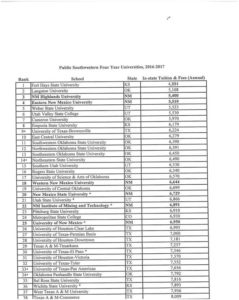
- The first HU: Learning Happens Here staff professional development event was held this week. At these events, HU staff are invited to voluntarily participate in a lunch discussion about the professional and or scholarly interests of an HU colleague. Participants receive a free brown bag lunch and meet over the noon hour to learn something new. The first event featured Dr. Brandon Kempner and by all measures, it was quite a success. Participants spoke highly of the experience, Dr. Kempner’s leadership during the session, and the quality of the food. Other brown-bag lunch events will be led by Mike Petronis, Orit Tamir, Jerry Cronin, David Lobdell, James Cohen, and Carol Linder. I’ll also do one sometime this spring term. Many thanks to the faculty and staff leading these discussions and to Laird Thornton (President of the Staff Senate) and Dr. Denise Montoya (HR) for organizing these activities. All colleges and universities should be places where learning happens. That is our mission and it is a noble one. This modest program is but a small manifestation of the wonderful and important role we play in society and the world.
- The wonderful artist and poet Valerie Martinez will serve as the commencement speaker at the Rio Rancho commencement event. Many thanks to Dr. Virginia Padilla-Vigil and her team for making this happen. A photo of Ms. Martinez:

Plans for the commencement celebration on the home campus are coming together. Some new ideas and possible new traditions are being considered. I have asked someone to serve as the commencement speaker on the home campus and will make an announcement about that when I have a response.
- Things continue to move forward in Strategic Enrollment Management. Our major push to gain students will commence in a few weeks now. In concert with our partners at Ruffalo Noel Levitz we will be contacting more than 25,000 prospective students employing modern digital and other approaches. In addition, HU recently sponsored our first High School Counselors workshop. More than 55 counselors were on campus to learn more about HU and what we offer students. A counselor from Robertson High School speaking with one of our staff:

- I think we are off to a great start with our new food vendor, Sodexho. I have heard positive reviews about food choices, quality, and service and as I previously noted, the catered meal for our prospective students from Chicago was excellent. A student advisory group to provide input to Sodexho will be established very soon and we’ll also establish some focus groups to provide input on our food retail option (now Einstein’s Bagels). In an attempt to provide some benefits to our employees, I am very pleased to announce that faculty and staff are charged $5 each and every day for lunch—an improvement over the arrangement with our previous provider. In an attempt to model good community citizenship, community members will eat on campus (lunch) for $5 every Wednesday. I have also tasked our new provider to make the so-called Executive Dining Room available any time that space is not otherwise scheduled. Hopefully, that space will provide a quieter and more relaxed dining space for HU faculty and staff. I am also working on an option to provide a for fee wine option to those dining in the Executive Dining Room. Obviously, whatever is done in that regard will have to comply with our new alcohol policy.
$5 Lunches For All HU Faculty and Staff—Every Day!
- As I think everyone knows, the football field needs to be replaced and we have launched a campaign to get the funds to make this happen. We are in the early stages, but a number of benefactors and friends of HU have already come forth and the fund is starting to build. Other fundraisers—golf tournaments and the like—are planned. This has already been a true “all hands on deck” project with participation by alums, HU employees, members of the local and broader community, board members, and others. Many thanks to VP Law and AD Clifford for their leadership on this initiative. Our Advancement team continues to move forward . We received a 5 figure check this week to build the endowment in a scholarship account and a four figure check to help support one of our athletic teams. Well done. Recruitment season is upon us and we have some outstanding and high-quality student athletes who have already committed to HU and more on the way. Many thanks to our coaches who work so hard behind the scenes to get these student athletes here.
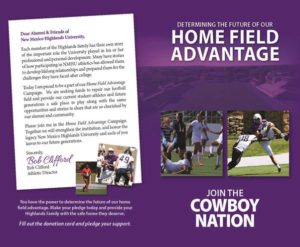
I should also note that the 2017 baseball season begins this Friday at 2:00 p.m. Other games will be played Saturday at 2:00 and Sunday at noon. Let’s show some support for our student athletes. Go Cowboys!!
- Over the next several weeks, I will be accompanying our student recruitment team to several local high schools. I’ll meet prospective HU students, maybe pass out a few t-shirts, and spread the news about the many advantages of a high-quality and affordable HU education. We have a great story to tell here and we need to get the message out.
- I hope you can attend the Rhythm of the Dance (the National Dance Company of Ireland) concert in Ilfeld on February 15. The concert begins at 7:00 p.m. No admission at the door for HU students with ID. General admission for non-students is $10.00 at the door. Kids five and under are $5.00. This professional group has performed on television (e.g., PBS) and in 60 countries around the world. For more information, go to: http://www.rhythmofthedance.com/.

This is an ARTS@HU event and supported by the Campus Life student fee. I should note that these performers will be in Cerritos, CA immediately before they perform here. I glanced at ticket prices for that CA concert and they ranged from $180-$436 and even more. A nice video of the troupe: http://www.rhythmofthedance.com/media-1
- The Board of Regents will meet this Friday and next week I will provide an overview of the various actions taken by the board. After the AGB training the board received, a recommendation was made to modify the board agenda to decrease the reports from the various vice presidents and other executives and to devote time for more in-depth discussions of other topics. At the next board meeting, we’ll spend some extended time discussing the budget situation (moving much earlier to a recommendation to the board), an overview of our program in social work, and an update on the Spanish program including bilingual education.
- From Dr. Brandon Kempner—This Week in HLC Accreditation: Here’s a shortened version of the update provided to the Board of Regents on February 3, 2017: 1. HLC Campus Visit: The HLC requested 3 dates for their Monday-Wednesday visit that must be completed by December 2017. Highlands provided them with November 6-8, November 13-15, and November 27-29. Our final Assurance argument will be due 30 days before the visit, and then we’ll work backwards for our formal Board of Regents review of the Assurance argument. HLC Upcoming Dates: Professional Development Week (2/13-2/14): Brandon Kempner and Jennifer Lindline are attending, with a focus on Student Learning Outcomes and Outcomes Assessment; NM Higher Education Assessment and Retention Conference (2/23-2/24): The state’s annual conference on Assessment and Retention; a variety of Highlands faculty and staff will be attending; Institutional Update (2/27-3/30): Max Baca, Buddy Rivera (OIER Director), and Brandon Kempner will provide enrollment and financial updates to the HLC; Annual Conference (3/31-4/4): President Sam Minner, VP-SEM Edward Martinez, and Brandon Kempner are confirmed to attend; Persistence and Completion Academy (6/19-6/20): A team of five will be sent from the Retention Advisory Committee. 3. Pushes and Priorities for February: Outcomes Assessment, March 1st deadline for 2015-2016 data; Center services; Completing Contingent Faculty evaluations for Fall 2016, February 15th deadline; Strategic plan updates.

Sam Minner, Ph.D.
President
Greetings colleagues. A brief update for the week of January 23-27:
- I am in routine contact with our new Provost and VPAA, Dr. Roxanne Gonzales. I have been through many of these transitions and you want to keep the new person up to date on campus happenings, but also recognize that they have a full-time job on their home campus. Like so many things—a good balance is the desired target. Roxanne and her husband will be out in March to look for housing and will move here in early April. I will host a meet and greet for folks on the campus and also invite interested community members. Here’s Roxanne sporting some HU gear and two new four-legged future residents of Las Vegas. Not sure what the dogs are thinking, but the one on the right seems to be carefully posing for the selfie while the one on the left is maybe thinking—we’re moving? And where is that? And who decided that? Was there a vote I missed?

The newest Cowgirl ready to get to work:
- You might see this story in local, regional, and national papers about Dick Greene who recently won a Jefferson Science Fellowship from the National Academies. I believe Dick is the first HU professor to win one of these and I think he may be the only professor from New Mexico to ever win one. If you go to the Jefferson Fellows website you will note (as is typically the case every year), this year’s Fellows are from top medical schools and large Research I institutions…with one notable exception—the guy from HU. Here’s the release:
HU Professor Named Jefferson Fellow
LAS VEGAS, NM – The National Academies of Sciences, Engineering, and Medicine named a Highlands University professor as one of its 2017-18 Jefferson Science Fellows. Ernest Greene, a professor of engineering and biology at Highlands, will begin his fellowship work in August, influencing science policy at the U.S. Department of State. Greene is one of 14 tenured professors from across the country chosen for this year’s fellowship. “It’s an opportunity for me to serve on a national level,” said Greene, who has been a member of Highlands’ faculty since 1992. “I’ve served in the bioengineering community around the world, so it’s great to be able to utilize all those experiences that will have an impact on a lot of people on a national and international stage.” The Jefferson Science Fellowship Program began in 2003 to collaborate with academic research communities to help form and implement U.S. foreign policy and international development programming. This year’s fellows include faculty members from Rutgers, Purdue, Pennsylvania State, the State University of New York at Binghamton, the University of Alabama, the University of Maryland, the University of Florida, North Carolina State, the Wayne State University School of Medicine, and Texas Tech. Highlands President Sam Minner said he is proud to have faculty members of Greene’s caliber at the university. “To have a world-class researcher – one who has been a visiting professor at large universities around the world – choose to teach at a university like ours because he believes in the transformational experience of science education is the mark of a rare man,” Minner said. “Today, far too many people are ignorant, fearful or antagonistic to the scientific process. It is Dr. Greene’s passion to change that.” During the course of his career, Greene helped introduce echocardiography, the use of ultrasound waves to study the heart, in New Zealand and China and started the first bioengineering program at the University of Brazil, Rio de Janeiro. He served on the editorial board of the Journal of Ultrasound in Medicine, chaired several research and review committees, and has 100 published manuscripts in peer-reviewed journals and two published books. Greene, who earned his doctorate from Colorado State University – Fort Collins, is a native New Mexican and the first person in his ranching family to go to college. He said he hopes his work with the fellowship with inspire a new generation of students. “I spend a lot of my time telling students you can be the best you can be,” Greene said. “You have to work hard.” Outside of the classroom, Greene coached the university’s two-time champion rugby team, the Vatos.“It will be good to have ol’ Coach Greene working in the State Department,” Greene said.
Here’s the announcement on the National Academies’ website:
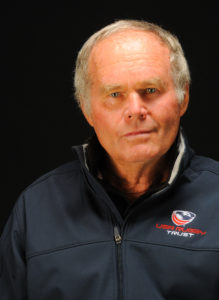
Ernest Richard (Dick) Greene
New Mexico Highlands University
Ernest Richard (Dick) Greene has been a Professor of Engineering and Biology at New Mexico Highlands University and a Research Professor of Engineering and Medicine at the University of New Mexico since 1992. He received his BS and MME degrees in Mechanical Engineering at Rice University and a PhD in Mechanical/Bioengineering at Colorado State University. He was raised on a family cattle ranch in rural New Mexico. After working in the oil fields during his college years and after graduation, he became an offshore Project Engineer for Brown and Root Inc. He served as a US Army First Lieutenant and Platoon Leader for 2 years in the Combat/Construction 34th Engineers during the Vietnam conflict. Subsequently, Dick was a Senior Scientist and Director of the Cardiovascular Laboratory for 12 years at the Lovelace Institutes. There, he was awarded an NIH Fogarty International Fellow. As an active biomedical engineer focusing on noninvasive anatomical and physiological measurements in human health and disease, he has been a Visiting Professor at major research universities throughout the world including Brazil, Chile, USSR/Russia, New Zealand, Denmark, China, India, Nepal, Bolivia, Canada, and most recently, Namibia. He has served on, or for, various major journal editorial boards and review panels within multiple disciplines. His numerous awards include Medical Volunteer of the Year by the American Heart Association and National Young Investigator of the Year by the American Academy of Orthopedic Surgery. His research has been funded by over 50 competitive grants from various agencies including the NIH (RO1), AHA (Grants in Aid), NASA, and VA (Merit Reviews). Two edited books, 12 chapters in books, and over 100 peer reviewed publications have been published with over 200 abstracts presented at international meetings. Dick has taught over 140 university courses, mentored 58 senior projects, senior advised 33 MS, 17 PhD, and 7 MD research theses ranging from thermodynamics and bioengineering to basic biology and human anatomy and physiology. Other interests and activities include sustainable farming and ranching, water management, educational outreach, wilderness preservation, women’s rights and family planning, and rugby (international player and coach of USA national championship teams).
- We will continue with the Big Ideas Reading Series this semester. This term, we’ll read Austerity Blues by Michael Fabricant and Stephen Brier. This book focuses on the “austerity movement” in higher education and provides another perspective on how some have attempted and are attempting to “starve the beast” (i.e., cut funding off to higher education to force institutions to change). Here’s a brief overview:
It is taken as an axiom in many administrative circles that public colleges and universities cannot rely on government funding sources to fuel their budgets in the future. A new book from a pair of City University of New York Graduate Center professors examines how that conclusion came to be and describes in blistering terms what it has meant for public higher education. In their book Austerity Blues (Johns Hopkins University Press), Professor of Social Work Michael Fabricant, who is vice president of CUNY’s Professional Staff Congress, and Professor of Urban Education Stephen Brier, who is coordinator of the CUNY Graduate Center’s Interactive Technology and Pedagogy Program, argue state disinvestment has had a deeply harmful impact on public universities’ ability to educate students as colleges and universities turn to the promises of privatization and technology. The effect, they write, is an era of austerity undercutting public institutions’ ability to serve the poor and working-class students who need them the most — an effect that has broad ramifications for society as economic and social classes diverge.
Here’s a more thorough review: https://www.insidehighered.com/news/2016/11/02/qa-authors-book-austerity-public-higher-education. We’ll order multiple copies of the book and the first faculty and staff to volunteer will get a copy and then join a group of colleagues from Northern New Mexico College for a good discussion. Rick Bailey, the new President of Northern and a great addition to the Council of University Presidents, and I will also join the group. The location and time of the discussion will be determined later.
- We continue to perform well in regard to the number of degrees we are awarding. I just received our most recent performance data from Michael Raine. In the fall term (2016), we awarded 127 graduate degrees (a 33% increase over our performance in fall, 2015) and 150 undergraduate degrees (a modest 3% increase over fall, 2015). These data are moving the right way and that’s great. Our overall enrollment numbers are not. Our best hope—Strategic Enrollment Management is now built. We have a new leader, a new head recruiter, all new student recruiters, new promotional materials, and for the first time, new and modern analytical tools to gauge our performance. There are still a few things that need to be completed to finish the engineering of this unit. One is branding. Sean Weaver and others have been working on a branding policy, a new visual identity, and other branding standards. Settling on these standards and then sticking to them are considered best practices in the enrollment management and PR domains. In the past, we’ve been a little lax on those (ever notice how many versions of the HU we have or how many images of the cowboy on the horse are floating about?). Our logo is quite similar to those of other schools and the last thing we should do is to use multiple images internally. I was in Nashville last week and someone asked me if I worked at the University of Wyoming. Like HU, they are the Cowgirls and Cowboys and their logo is pretty close:

Our new proposed standards may go before the board at the next meeting. I recently completed a webinar regarding best practices in student recruitment in the 21st Century. The advice from the webinar: (1) highlight the importance of recruitment by making it prominent in the organization (do not bury it in some other unit), (2) get the right people and enough of them working on recruitment (in the past, only a few people worked on this because they were not required—the students just came), (3) employ modern recruitment practices (that basically means to use technology much more than in the past—the old approach of dropping by a high school and giving the counselor and a few students some brochures does not cut in 2016), and use good analytical tools so you can make corrections if things are not working. Recruitment is really tough these days, but some schools continue to do well (for example, Eastern). Keep in mind that Eastern has suffered state budget cuts just like everyone else. But, they continue to grow. They are now above 6,000. We have been going the other way. My bottom line—we simply must improve our performance in this area. But, it is also great that the number of degrees awarded data are trending up. We should celebrate that.
- The Campus Life initiative continues to produce positive outcomes. This past weekend, 38 HU students (from the home campus, Santa Fe, and Albuquerque) did a ski trip to Sipapu. Pick up in the a.m., travel to Sipapu, no cost (at the door) for board or ski rental, no cost lift pass at the door, a full day of skiing, and then return to the campus. Three more ski trips are planned this spring term. We are currently negotiating with a local artist for a mural to be hung in the Outdoor Recreation Center. The mural will be on canvas so we can move it as needed. Also in Campus Life—fifty-one HU students watched the football playoff game last weekend and enjoyed free snacks and soft drinks. In a couple weeks, we’ll also host a SuperBowl watch party with free pizza and soft drinks. It is really great that more HU students are actively participating in the many wonderful outdoor activities in our area. That they are also getting to know new friends, participating in fun and healthy activities, and…remaining on campus to a greater degree are all additional plusses. Perhaps most critically, the positive link between a vibrant campus life and overall student retention is well established. A photo from the ski trip last weekend:
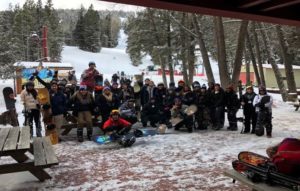
An announcement regarding the major spring music acts will be made as soon as the contracts are finalized. We are also working with several performers to book them for events next academic year.
- We are starting the initial process for the renovation of Rodgers. It will be a tight budget to do everything we need to do, which includes significant mechanical, plumbing, and electrical upgrades. We must also do some abatement work, replace the roof and windows, and do some stucco renovation. The elevator in the building must also be replaced to come up to code. Plus, we simply must preserve the wonderful WPA murals in the building and since this is another historical building on our campus, we must also meet the relevant standards of a historical renovation. I met this week with Ms. Sylvia Baca who will be overseeing the Rodgers project and as was the case with the Trolley Building, we are both committed to coming in at (or below) budget with no excuses. I should also note that Sylvia will be taking an overall project management role on this project (with no additional remuneration) in order to save money—that role is typically outsourced. I thank her for that demonstration of high campus commitment and good citizenship. Sylvia did a great job with the Trolley Barn project and I have high confidence that the Rodgers project will also be a great success.
- Last year a number of HU folks met with Mike Koldyke and John Byrne to establish the Chicago Scholars Program. In this program, some prospective HU students will visit our campus and in some cases also visit with our coaches to initially talk about playing for HU as student athletes. The goal of the program—provide a high quality and affordable educational experience for some students from Chicago. If they have the ability to play on one of our teams—so much the better. I also like the fact that this program will add some regional diversity to the campus. The first group of prospective Chicago Scholars will be on the campus this weekend. They will be staying at the Plaza and in our residential facilities and we have a full itinerary for them so they can get a good feel for HU and Las Vegas. Joan and I will be joining them (and their parents) for dinner on Saturday. Many thanks to AD Clifford and everyone who helped make this happen. We are on the front end of the campaign to replace the turf on the football field, but some friends of HU are already stepping forward to help. This week, we received a $1,000 check from a business group in town and were informed that another $3K (from another source) will be coming soon.
- Many thanks to everyone who attended the HLC update meeting on Monday afternoon. We are making good progress in all HLC areas of concern. Dr. Kempner is doing an excellent job of keeping everything on track and moving us closer to a strong Reaffirmation document.
- On Tuesday I attended the Council of University Presidents (CUP) meeting in Santa Fe. University presidents met with Secretary Damron and representatives from the Legislative Finance Committee. We discussed the various higher education bills filed thus far and discussed our collective position on them. It seems to me that many legislators believe that higher education has been cut quite enough and additional cuts would likely reduce our ability to serve students. However, some comments about additional deep cuts are still heard. It is early in the session. I’ll keep in touch with the campus as things become more clear.
- On Wednesday evening, Joan and I along with a group from HU attended the Hispano Round Table Dinner in Santa Fe. This is an annual event honoring Hispanic legislators in our state. Joan and I were joined by several HU folks and our new Student Regent, Mr. John Ramon Vigil. I heard a number of inspirational speeches at the event, but none more so than the remarks made by the Honorable Javier Gonzales, the Mayor of Santa Fe. Mr. Gonzales speaking at the event:
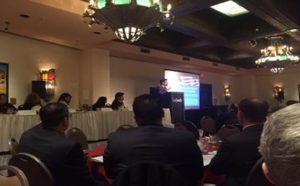
- A representative from the HLC contacted me this week and asked for some possible dates for the visit the team will make this fall. Dr. Kempner and I will make some suggestions and I’ll let everyone know when things are set.
Dr. Kempner’s weekly update on HLC matters: This Week in HLC Accreditation: I’ve added several new links to our HLC “Evidence Archive” webpage, located at http://www.nmhu.edu/accreditation-information/evidence-archive/ . This includes information on the Contingent Faculty Handbook, our retention and recruitment efforts with Ruffalo-Noel-Levitz, Strategic Plans, and Outcomes Assessment. Dr. Edward Martinez came to the General Faculty meeting on Wednesday 1/25/17 to discuss recruitment and retention, an important probation area. If you missed the HLC forum on Monday 1/23/17, where Dr. Minner made some remarks about the HLC and then we took a deep dive into the Contingent Faculty probation areas, that is now uploaded to our forums page at http://www.nmhu.edu/accreditation-information/forums/ .
Have a nice weekend my colleagues.
Sam Minner,
President
Greetings colleagues. A brief update for the week of January 16-20.
- It is boring around here when no students are on campus. What to do? Go to the Secret Lives Of Presidents: https://www.facebook.com/HighlandsUniversity/posts/10153950308776292?comment_tracking=%7B%22tn%22%3A%22O%22%7D
- I know that several activities took place on MLK Day. For example, several of our students and faculty participated in a program in Albuquerque. But in general, I was disappointed that the campus did not have a larger and more formal recognition of the day. I will work with Kim to see what we can do next year. If you have thoughts, let me or Kim know. It might be best to think about a week-long lineup of events. Maybe a film one day, maybe a panel discussion the next, etc. I have worked on campuses where there was a convocation to celebrate MLK Day. Classes were cancelled and everyone was expected to attend. We had a guest speaker and a reception for the speaker. I am very willing to consider that if that is something the faculty want to do.
- The new legislative session kicked off on Tuesday. It will be an interesting sessions, no doubt. A recent article about the situation in NM: https://www.abqjournal.com/928028/budget-woes-cast-shadow-over-60day-session.html. I assure you that HU has done and is doing everything we can do to put our best foot forward and make our case. These efforts are largely organized by the Council of University Presidents (CUP). Max is well regarded in Santa Fe and lots of people, including many elected officials, rely on his expertise during the session.
- The Highlands University Campus Community congratulates Regent Frank Marchi on his six-year reappointment to the NMHU Board of Regents. Also, we welcome and congratulate John Ramon Vigil as our new Student Regent serving a two-year term. We thank them for their public service to Highlands University.
- HU is organizing a larger and more vibrant intramural program for the spring term. Participation in intramural sports has been carefully studied over the years and participation is related to many positive and desirable outcomes including overall fitness, retention, and affinity for alma mater. Many alums have fond memories of their participation in intramurals and have questioned me about why we are not doing more. Now, we are. I thank Margaret Gonzales and her team for reviving these activities on our campus.

- Great College Deals recently named HU to the top list of online MBA programs. In this ranking, you get points for small class sizes, student body diversity, and affordability. We were ranked #9 in the nation. Here’s what they said about us:
#9 – New Mexico Highlands University
Las Vegas, New Mexico
New Mexico Highlands University – best online MBA programs
Points: 5
Graduate Tuition/Fees: $4,776
The School of Business, Media, and Technology at New Mexico Highlands University offers a Master of Business Administration that makes our list for the most affordable online MBA degree program. For under $5,000 annually, graduate students may work at their own pace to satisfy requirements needed for the online MBA. What is unique about New Mexico Highlands University’s MBA program is the required case write-up and oral presentation due prior to graduation. Instead of a thesis, students present a case solution to an oral examination committee. Upon completion of courses and the case solution exit requirement, students earn an online MBA degree from an accredited institution.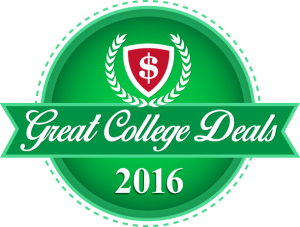
- Early Tuesday morning, I welcomed a group of prospective HU students to campus and shared with them the many attributes of a high-quality and affordable HU education. Some of the materials we are now sharing with these students:
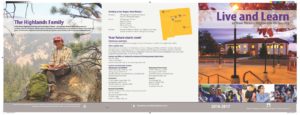
- I was in Nashville, TN during the second half of the week at the national NCAA meeting. This is a very large meeting and is a bit of a command performance for university presidents and chancellors. I attended several good sessions—one focusing on student-athlete mental health, one focusing on the most recent science related to concussions, and one that focused on the nexus between athletics and recruitment. I also heard some speakers talk about why they thought collegiate athletics was so important. One of them referenced this essay (now, several years old). It is a classic. Go to: http://www.nacubo.org/Business_Officer_Magazine/Business_Officer_Plus/Bonus_Material/College_Athletics_Necessary_Not_Just_Nice_to_Have.html.

- This Week in Accreditation: Our next HLC forum will take place on Monday January 23, from 3-4 PM in the SUB Ballroom. We’ll be discussing the upcoming HLC conferences, our path forward with our volunteers and writing the Assurance Argument, and then probation areas related to Contingent Faculty, namely evaluation and orientation. The Executive Management Team will be meeting on Friday 1/27 to finalize the budget priorities for next year, and then that information will be shared with the campus community. Finalizing the 2015-2016 Outcomes Assessment process will be a major point of emphasis over the next month, and Jennifer Lindline, Diana Marrs, and I are meeting on Friday 1/20/2017 to discuss our next steps regarding that important probation area. This week, Highlands signed an MOU with San Juan College to provide additional student services at the Farmington center.

Have a nice week my colleagues.
Sam Minner,
President
Greetings colleagues. A brief update for the week of January 9-13.
- We have a new and permanent Provost and VPAA—Dr. Roxanne Gonzales. Roxanne comes to us from Clarion University (Pennsylvania) and has held other postings at Regis University and Park University. Roxanne received very strong recommendations from the search committee and I also received very favorable comments from members of the HU community who were able to attend one of her on-campus sessions. I completed my due diligence vetting and heard nothing but rave reviews about her work. I could not be more pleased to have her join the HU team. She will move to Las Vegas and begin her posting here in early April. A photo of Dr. Gonzales:

Roxanne Gonzales
In case you missed it, this is the story on our website:
LAS VEGAS, NM – Roxanne Gonzales knows firsthand how education can change a community. “My father grew up in the South Valley in Albuquerque and was the first in his neighborhood to graduate from college,” Gonzales said. “His legacy fueled in me a dedication to serving individuals who have a desire to gain an education.” This spring, Gonzales will become New Mexico Highlands provost and vice president for academic affairs, a transition, she said, that will continue fulfilling her father’s legacy. “I believe in the mission of Highlands,” Gonzales said. “For me, coming to Highlands is coming home.” Gonzales comes to New Mexico Highlands from Clarion University in Pennsylvania where she serves as executive dean of Venango College. “Under her leadership, the Venango College faculty and staff grew enrollment in existing credentials in nursing, counseling, the health sciences, and nutrition and fitness among several others,” said Clarion University interim Provost Todd Pfannestiel in an email to the institution’s faculty and staff. “These efforts included the development of a graduate level credential in mental health counseling and a certificate in concussion management. Furthermore, enrollments in the comprehensive credential ladder in nursing reached all-time highs.” Gonzales said she was interested in New Mexico Highlands because of its possibilities. “It’s a place of growth, and it’s on the verge of expanding,” said Gonzales, who earned her Doctor of Education degree in higher education administration from the University of Massachusetts Boston. “Highlands isn’t a standard public institution; it has a very special mission.” Highlands President Sam Minner said Gonzales’ extensive background of providing access to higher education will help the university better serve more students from all backgrounds. “Dr. Gonzales has a strong belief in the importance and life-changing aspects of higher education,” Minner said. “Her background of collaborative leadership and innovation brought her to the top of an impressive pool of applicants.” One of Gonzales’ first academic positions was a guidance counselor in England with the U.S. Air Force. “The military is at the forefront of educational technology and access,” Gonzales said. “It helped me better understand the needs of learners and put a global perspective on education. It also taught me how to serve students at a distance and do it well. “I have a deep belief in access to higher education, which is why my career has been focused on open access, alternative models for learning such as online, and serving first-generation, high need learners.” During the course of her career, Gonzales worked as a faculty member and in administration as well as the CEO of Zia Higher Ed Consulting, a start-up firm specializing in helping colleges and universities develop programs to serve nontraditional students. Her background includes deanships at Clarion University, Regis University in Denver, and Park University in Kansas City, Missouri. “At Highlands and in higher education generally, we have to be concerned about how we’re addressing individual student needs,” Gonzales said. “We need to collaborate with other institutions, both public and private, and take a look at technology to find innovative ways to serve students.” Gonzales said she believes the most successful innovation occurs in an environment where different viewpoints can be heard. “To come up with a whole, it’s important to recognize what each person brings to the table,” Gonzales said. “A project has a much higher chance of being successful when you have more people in the conversation.”
Dr. Carol Linder will remain in the interim role until Roxanne arrives and the existing structure in Academic Affairs will remain in place at least for the remainder of the spring term. The overarching goals in the ultimate structure in Academic Affairs are to produce high outcomes and efficient operations at the lowest administrative cost. From my perspective, both variables are important. One can produce decent outcomes if you are paying lots of people to do tasks, but in many cases, that simply costs too much. However, you can cut those costs to the bone and produce low outcomes (and burn people out) if too few people are around doing things. Finding that sweet spot is the goal and it can be tricky. Nonetheless, I am committed to high outcomes in our administrative and managements operations and, to the degree possible, reducing administrative costs at HU. For example, we have recently eliminated one Associate Dean position. Other administrative savings are planned, but…our administrative/management outcomes have been a problem here in some cases and I will not allow those to slip.
We all owe a great debt to the colleagues who have worked and are working in these interim roles. Carol is doing a great job and brings more enthusiasm to the job than anyone can imagine. What a great soldier for HU. She is the true HU energizer colleague. Jim has done and is doing great things in grants and contracts. Few people understand how close we were to losing the USDA grant with Dine College and without Jim’s hard work (and the work of others), we would have lost it, no doubt. Warren has done a wonderful job in the Graduate College and has taken on other key and challenging leadership roles without hesitation. When you see these folks, you should thank them for their efforts and their many successes. Those who have not done these jobs have little idea about how complex and demanding they are.
I know something about interim appointments. I have held several of them myself and have started new jobs with an interim in place when I began. Interim postings are unique. Several years ago I published a little thought piece on interim appointments and I’ve probably received more requests for reprints on that than any of my “scholarly work”—which frankly, probably says more about my scholarly work than anything else. Here it is: http://www.chronicle.com/article/An-Unhappy-Interim/44541/.
- We also have a new football coach—Marty Fine. Marty previously served as the head coach at Bryant University where he led the Bryant team to many victories and a great region al and national reputation. Marty began his service to HU on Monday, January 9. He is residing here in Las Vegas. A photo:
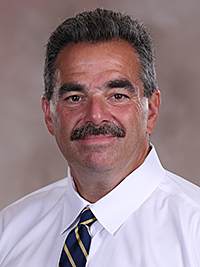
Marty Fine
A releases from the Providence Journal: http://www.providencejournal.com/sports/20170110/ex-bryant-coach-fine-hired-as-interim-coach-in-new-mexico . A nice story from today’s ABQ Journal:
College football: Fine returns to NM to fix Highlands program
By Ed Johnson / Assistant Sports Editor
Friday, January 13th, 2017 at 12:05am
Marty Fine arrived briefly in New Mexico in 1984, an ambitious young man, going from New York City to Silver City. “I was young, living on a block with 10,000 people, moving to a town with less than 10,000,” Fine said. “It was a culture shock at that age.” After a nearly 32-year absence, he is back. Football was the reason then. It is the reason now. Fine, 56, has taken the reins of the New Mexico Highlands football team, a program that is 7-37 since 2013. “I’m a fixer,” Fine said. “It’s what I do best. I take something that’s broke and fix it.” In 1984, he was a former Union College Dutchmen linebacker looking to get into coaching. Mike Drake, at the age of 27, had just been named head coach at Western New Mexico and he was in need of some young assistants. Through a series of connections, Drake found Fine. Fine admits now he did not fully appreciate the beauty and charm of Silver City at the time. But as he earned his bachelor’s degree at WNMU, his coaching career was born. The Mustangs, with Fine in charge of the linebackers, went 7-2-1, 7-0-1 in the RMAC, then affiliated with the NAIA. A season later, it was on to Sonoma (Calif.) State. Then he got a job closer to home as head coach of the U.S. Naval Academy prep school in Newport, R.I. There were also assistant stints with Indiana State, Colgate, Indiana and Iowa State. In 2004, he took over as head coach at Bryant University in Smithfield, R.I. Part of his job became to oversee the Bulldogs’ move from NCAA Division II to NCAA FCS status. After going 80-61 at Bryant, Fine resigned in December. The place no longer needed fixing. “I was going to retire, or at least take a year off,” Fine said. Then Bob Clifford called. Fine’s formula for fixing a program hinges on people. He believes Highlands, starting with athletic director Clifford and NMHU president Dr. Sam Minner, has the right folks. Clifford, who took over at NMHU in January 2016, had been a longtime associate AD at Oregon State (and is a published poet). “The athletic director is one of brightest men I’ve ever met,” Fine said. “He has a great background and knowledge. For the place to have Bob Clifford as athletic director, I think they should really be honored.” Fine, these days, is a staff of one, but is in no hurry to hire. Signing day is Feb. 1, but he is no rush there, either “The first thing I have to do is learn the school so I can represent it properly,” Fine said. He said he has talked with many of the players and while it is too early to assess their talent, he is impressed with them as young men. “I think they’re excited to move forward and figure out what we’re going to do and how were going to make it better,” Fine said. “They’re good kids and want to be successful.” He plans on using a pro-style offense and establish the run (he will call the plays). He wants his defense to be gap sound and stay off the field as much as possible. He still takes much of his philosophy learned all those years ago from Mike Drake. He said NMHU’s plan for athletics, its student center and training facilities are in place. The New Mexico Highlands Foundation has started a campaign to replace the 14-year-old football field at a cost of $450,000. “The bones of this place are really good, better than a lot of places I’ve been,” Fine said. His previous stop in New Mexico was brief. He plans on a longer stay this time. “I’ve done this before; it’s not a quick fix,” he said. “I intend to build something that will stand the test of time.”
Here’s the story on our website:
LAS VEGAS, NM – Major changes are in store for the Cowboys football team both on the field – literally – and off. The New Mexico Highlands Foundation is conducting a fundraising drive, the Home Field Advantage Campaign, to replace Highlands’ 14-year-old football field, and the team will be led by a new interim head coach, Marty Fine. “We are opening the door to a new era for the Cowboy Nation,” said Highlands Athletic Director Bob Clifford. “The new field will provide our current student-athletes and future generations a safe place to play along with the same opportunities and stories to share that are so cherished by our alumni and community.” The field is used by the football and soccer teams as well as the two-time champions Vatos rugby team. Additionally, the field is used for drills, conditioning and community games and recreation. Clifford said due to its age, the field has become hazardous for athletes, and the Rocky Mountain Athletic Conference informed the university it might not be permitted to host home football games on the field unless repairs are made. The cost to replace the field is $450,000. “We’ve had some strong community support during the start of the campaign,” said Theresa Law, Highlands’ vice president for advancement, which works with the university’s nonprofit foundation. “This is an important project in terms of recruitment, campus life and community pride.” Law said this year’s Highlands Loves Alumni event on Feb. 9 will help raise funds for the Home Field Advantage Campaign. “Last year, we had a great turnout from alumni and friends to raise funds to promote high-impact practices for our students,” Law said. “This year, we’re hoping our alumni and friends join us to help replace the field. This year will also see a new leader for the football program, interim Head Coach Marty Fine. Marty understands the two most important things to make Highlands football successful,” Clifford said. “Our athletes are students first, and we’re in it to win.” Fine officially took control of the program Jan. 9. “Highlands is the perfect job for me,” Fine said. “What I’ve done best in my life is build strong programs, and we’re going to do that here.” Fine brings more than 35 years of coaching experience to Highlands with a strong record of improving struggling programs. His previous position was at Bryant University in Rhode Island, where many of his players received Northeast Conference Player of the Year Awards. “My goal for the program is for each student to have a positive experience in the classroom, in the residence halls, in the community and on the field,” Fine said. “To do that, you have to work with really great people and with people who care. Highlands has all of that.” To contribute to the Home Field Advantage Campaign, contact the Highlands Foundation at 505-454-3248 or by email at tlaw@nmhu.edu.
I encourage people to consider giving to the field campaign. The field is used by many folks—not just the football team. This is something we just have to do.
- Also on the personnel front, two HU folks earned a big “Thumbs UP’ in today’s Optic—the new Dean of the Facundo Valdez School of Social Work, Dr. Cristina Duran, and our wonderful leader in recycling, Ms. Carmen Lopez:
THUMBS UP! NEW DEAN FOR SOCIAL WORK
A Highlands University social faculty member now has a new title. The University has announced the appointment of Christina Duran as the new dean of the Facundo Valdez School of Social Work. Duran is no stranger to the area, having served as the school’s interim associate dean since July 2014. She brings impressive credentials to her new position. She earned her Ph.D. degree in American Studies and has a Master’s degree in Social Work from UCLA. We look forward to her assuming duties as dean for the growing department.
THUMBS UP! AN HONOR FOR RECYCLING
Carmen Lopez, the recycling coordinator for Highlands University recently received top honors as the New Mexico Recycling Employee/Operator, by the New Mexico Recycling Coalition. Sarah Pierpont, director of the New Mexico Recycling Coalition, said of Lopez, “Carmen cares deeply about her recycling center, which is evident in the quality of the recyclables the center produces that are always sorted properly.”
- On Tuesday, I welcomed about 35 students from Coachella Valley to our campus. They visited with several academic units, toured the Outdoor Recreation Center, and learned all about the many benefits of an affordable and high-quality HU education. Many thanks to Jessica Jaramillo and Edward Martinez for organizing this event. My poor attempt at a selfie with the Coachella group:
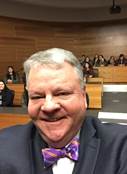
- We have made a change on our food service vendor and Sodexho is now on campus. In the short term, they will continue to work with Einstein’s, but soon they will poll students to see what direction we might take in the future. I am optimistic that outcomes will improve with this new provider. Sodexho has agreed to form a student advisory committee and make better use of the second floor dining area including the so-called Executive Dining Room. Max and I are working with them to hopefully continue with the $5.00 lunches for all diners (including members of the community) one day per week.
- Dave Trites, our consultant from Ruffalo Noel Levitz, was on campus this week and assisted Edward (and others) in writing the most recent draft of our institutional retention plan. As you know, student retention is one of the key areas of concern by our accreditors. The HLC obviously wants retention figures to be high (who does not?), but their concern was and is less about retention statistics than when asked for our plan, we really could not produce anything like a document regarding how we hoped to improve retention. Now, thanks to the efforts of so many good faculty and staff, Edward and his team, and our technical consultants, we have such a plan. Our 79 page institutional plan includes a brief history of our previous efforts to improve our outcomes, a great deal of data about how we have done and are doing in the area, and a multi- point plan to improve our performance. The plan is now in place. Now it is time to implement, make adjustments as we deem necessary and prudent, and see how everything works.
- One office that has been the topic of lots of conversation here is HR. In my experience, that important operation is often roundly discussed on most campuses—over my years on multiple campuses, I’ve heard many of the same things—things happen too slowly there, processes are confusing, boundaries of responsibility are unclear, etc. Sometimes these issues are quite legitimate and in some cases, at least in my experience, they are the result of a lack of understanding about what is required in modern HR operations. But still, HR is often at the center of many concerns. Our new HR Director, Dr. Denise Montoya, has already made many improvements in our HR operation and more to come. She is seeking funding for an “onboarding” software program that will streamline the hiring process and make the hiring process much more clear and transparent. Next week, she’ll launch the HU: Where Learning Happens program. In that program, staff members from around the campus are invited to a (no cost) brown bag luncheon and hear a bit about what a faculty or staff member is up to—most likely an area of their research. Dr. Brandon Kempner will lead the first session. Everyone will enjoy a free lunch and learn something new. Several other faculty members have already volunteered to do one of these. I will do one myself in a few weeks. I am also very pleased that HU is now working with the Division of Vocational Rehabilitation to provide temporary employment to an individual needing some work training to ultimately get back into the workforce. We should be engaged in this kind of thing as an institution and now…we are. I am very pleased with how things are working in HR and look forward to more improvements this term.
- There are no infant changing facilities in several of our restrooms, particularly some frequented by the general public (like in Wilson). These will be installed soon. I was in the men’s room during one of our basketball games and a guy was changing his little one on the floor—not acceptable—so we’ll install some appropriate facilities.
- We’re about to open a new space in the SUB where campus tours will originate. The space where the ATM is located in the SUB has basically been vacant since I’ve been at HU. It is a nice space, but as I wrote, it sits empty. I really have no idea what the plan for that space was originally, but it is a small, but prime piece of real estate and now is being put to good use by our Recruitment Office. Our new brochures are in there along with a refrigerator so we can provide some refreshments to campus visitors and a decent sectional sofa so people can relax before tours begin. On some campuses I’ve worked, the spaces where tours originate are the nicest spaces on the entire campus. First impressions count a great deal and now…we have a decent space for this activity.
- Things are starting to heat up prior to the new legislative session and much is being written about the upcoming budget situation. I won’t forward all the articles in recent outlets—there are just too many of them—but here’s one in the event you missed it: https://www.abqjournal.com/925766/key-nm-legislative-panel-unveils-6-1-billion-spending-plan.html. Over the break I tried to catch up on my reading a bit and came across this interesting graphic. It reflects spending up to the end of 2015, but I don’t think the overall trend changed much in 2016. Most people I know do not think that we’re ever likely to ever return to pre-recession funding levels. There will ultimately be new models of funding that will have to be devised. One of the most common I’ve heard—a drastic reduction in the number of four year schools around the nation. In one plan, most students will receive incentives to start at two-year schools (very low cost or maybe free) and then transfer, if they want a four year degree, to a much smaller number of four year schools specializing in certain disciplines—one school for health and allied health disciplines, one school for STEM, etc. In this model, states will not have to support multiple programs in liberal arts disciplines (say, ten Departments of English if a state supports ten public schools) on multiple campuses. In this model, each state might support at least one public liberal arts four-year school—maybe like the existing Council of Public Liberal Arts Colleges (COPLAC) schools for students who want to major in a liberal arts discipline. At present, New Mexico really does not support a public liberal arts school. I once worked at one—Truman State. Obviously, there are many issues and potential problems with this approach. For one thing, some students simply do want to start at a two-year school, but I suppose if the incentives were high enough (like very low or free tuition), they might do so.
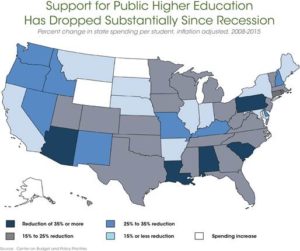
- On Wednesday, I hosted a Coffee With The President session on our Rio Rancho campus. There was a great turnout and an equally great discussion. I am pleased that we have made some improvements in regard to the interactions between the main campus and the centers, but much more should be done. I continue to hear issues like—it takes too long to get an answer from the main campus—we have students at the centers who need and want certain programs and classes and they are not scheduled at center locations—we say we want to build enrollment and we (those at the centers) can help with that, but we are stifled—and more. The spring term will be a busy one, but further improving the interactions between the centers and the main campus is on my radar. I don’t believe that anyone—at the centers or the main campus—desires to work at cross purposes. I don’t see that at all. I see this as a more structural issue and that is how I will address it. We simply must make the connections between the home campus and the centers more robust. We continue to face many enrollment challenges on the home campus and large student populations are near our centers. To not take advantage of that is foolish, in my view. Really, why support the centers if we do not have an all-hands-on-deck approach to serving students at those locations?
I was struck by the enthusiasm of the folks at Rio. They are good colleagues and demonstrate a real “can do” attitude. For that, I thank them. Dr. Virginia Padilla Vigil is a doing a great job there and the entire faculty and staff are really quite wonderful.
- We have a nice lineup of spring activities in Campus Life. Our first ski excursion was extremely popular and I think we have 3 or 4 more of them scheduled for this spring. Students sign up, we pick them up on campus and transport them to Sipapu, they receive a lift pass and a ski or snowboard rental at no cost, and we bring them back to campus at the end of the day. What a deal for a $75 student activity fee. A single ski trip would cost someone much more than $75 if someone did it on their own. We have the contract for our major headliner for this spring—a popular singer—and we’ll be making that announcement as soon as the contract has cleared legal scrutiny. I think the next act at Ilfled will be a troupe of Irish Dancers…again, there will be no fee at the door for HU students.
- This Week in Accreditation: As the University starts back up for Spring 2016, we’ve made some important progress on several of our probation areas. Department chairs now have access to all Contingent Faculty course evaluations from Fall 2016, and will be using these to complete their evaluation of those faculty members. The online orientation module is also ready for Contingent Faculty. On Thursday (1/12), Kim Blea led a meeting on Co-Curricular Assessment, where Co-Curricular programs such as ARMAS, the Writing Center, the library, etc., will use the Co-Curricular Assessment process to assess and improve their programs. Lastly, mark your calendars for Monday January 23, 3-4 PM, SUB Ballroom, for our next HLC Update forum.

All the best, my colleagues.
Sam Minner,
President
Greetings colleagues. A brief update for the week of January 2-6, 2017.
- There have been several changes on the personnel front. Provost Linder previously sent out an announcement regarding the new and permanent Dean of the Facundo Valdez School of Social Work. Dr. Cristina Duran started her new duties this week. We have come to terms with a new and permanent Provost and VPAA. There will be an announcement about that as soon as we receive her signed contract. That should be very soon. We have a new and permanent Director of IT, Joe Gieri, who is bringing new ideas and a new perspective to IT. He has already started. We have also hired a new Director in our Nursing program. Jeanie Flood will be leading that important program. Finally, we will be making an announcement about a new coach very soon. This announcement will be made in conjunction with the launch of a campaign to replace our football field. We have already received several gifts even before the campaign has been formally launched. I am very very pleased with these personnel changes and I am hopeful—really more than hopeful—that these individuals will play key roles in strengthening HU now and well into the future.
A good mentor of mine once told me to get the right people in the right jobs at the right time and…you are doomed to success. I believe that now more than ever. As a younger manager and leader, I focused on the ORG chart and drawing those lines just the right way. My feeling was that getting all that right would result in great outcomes. Today, I still think that matters, but it pales in comparison to the people in those little boxes on the ORG chart. If they are people of integrity, if they try hard every day, if they are true (and not in name only) servant leaders, if they demonstrate a good work ethic, if they engage problems by thinking about and acting on what they can personally do to make things better (compared to asserting that something is really “not their job” and leaving it all to someone else), if they demonstrate courage in the face of adversity, and if they are good colleagues to be around—well…..we are doomed to success and given these recent hires, I believe that our future will be successful.
- Speaking of fundraising campaigns, the end of the year saw a flurry of donations to HU. We received multiple five figure gifts to support various scholarships and other funds and one six figure gift. Numerous advancement and alumni activities are already planned for the spring term. Many thanks to VP Law and her team in Advancement for leading these efforts. About a year ago, we had no leader in Advancement (I was doing that job in addition to my own and doing it poorly, I’d say), we had no annual fund leader and thus, no annual fund campaign, we had no tip of the spear in alumni affairs, no alumni board of any kind, no clear idea of what our art holding were worth or really, what art we had, and a set of policies and procedures that had not been updated in many years. Today, we have a new and strong leader, an active annual fund campaign led by an annual fund officer, a much more vibrant program in alumni affairs and a good leader in that area, a (nearly) complete accounting of our art holdings, and modern and up to date board policies and procedures. Members of the Foundation Board recently met with an AGB consultant and had a good discussion about state-of-the-art approaches to foundation board membership. In my view, the Advancement team is strong and well situated to improve our outcomes in that area.
- I am also pleased with how things are coming along in the recruitment area. The overall plan, developed by the faculty and our partners at RNL, is now set and the major push to add students will formally begin February 13. On or about that day, our partners at Ruffalo Noel Levitz will send the first of nine emails to approximately 20,000 prospective students carefully screened as students potentially interested in HU. These are students who “fit” our demographic and are similar to students who have been attracted to HU in the past. No more random emails or mailings in the hopes a student might be interested in HU. Those pre-screened 20K will be added to about 7,000 names we already have in our system right now. Students will receive targeted emails (that is, if someone indicates they have some interest in HU after the first email, they’ll get a different one the next time around). There will also be direct mailings to some of these students and many of them will also receive phone calls. This approach is but one major push in hopes of enrolling more students. The new student recruiters under the direct leadership of Jessica Jaramillo will visit many high schools and college fairs and we now have more and much better recruitment materials to share with them. We will also be visiting many more transfer fairs in the hopes of getting our transfer numbers up. We are revamping our campus tour program to make it more up-to-date, modern, and welcoming. Finally, Dr. Warren Lail is assuming overall leadership for graduate student recruitment and we hope for some improvements there.
The schools with high cachet do not need to recruit. They simply draw a line and accept everyone above it. However, there are really only a few schools like that. These days, everyone else must actively recruit. The new approach we are employing will improve over time. Using new technology, we will send even more targeted messages to prospects and we’ll also work more on our messaging in printed materials.
We’ll see how this new approach works, but I am very pleased that it has been engineered and implemented so quickly. The new Division of Strategic Enrollment Management (SEM) was conceived last fall and established last spring—only about nine months ago. In less than a year, the unit is fully up and running with a new leader, a new head recruiter, all new student recruiters, a new Native American recruiter, new and exciting promotional materials, a new branding campaign and proposed visual identity, and new analytical tools. Most of the credit should be given to Dr. Edward Martinez who is managing and leading this unit. In my view, SEM is now soundly engineered…now it is time to perform.
- I am very pleased to announce that one of our own, Dr. Dick Greene, has been selected in the latest round of Jefferson Science Fellows (JSF). The JSF program is administered by the National Academies of Science, Engineering, and Medicine. The Academies annually select about a dozen American scientists to support the missions of the U.S. Department of State and particularly the U.S. Agency for International Development (USAID). The Fellows spend one year abroad working with scientists from other countries. Dick will start his Jefferson posting this fall. Former Jefferson Fellows have come from top tier institutions around the nation including Harvard University, Yale, Michigan, MIT, Cal Tech, and many others. Today, a professor from HU joins their ranks. Here’s a bit more information about this program taken from their website:
“Tenured, or similarly ranked, academic scientists, engineers and physicians from U.S. institutions of higher learning, who are U.S. citizens, are eligible for selection as Jefferson Science Fellows (JSF). Each Fellow will spend one year at the U.S. Department of State or the U.S. Agency for International Development (USAID) for an on-site assignment in Washington, D.C. that may also involve extended stays at U.S. foreign embassies and/or missions. All JSF assignments will be designed in consultation with regional and/or functional bureaus within the U.S. Department of State or USAID. Since the program is a collaborative effort between the U.S. academic community, the U.S. Department of State, and USAID, financial and institutional support for the program is shared among these partners. Fellows are paid a per diem of up to $50,000 to cover local living expenses (see exceptions under terms listed here) and an additional $10,000 is awarded for travel associated with their assignments at the U.S. Department of State or USAID. Additional travel support may be provided by the Fellow’s office or bureau. While in general JSF assignments will involve providing up-to-date expertise in the rapidly advancing science, technology, engineering and medical arenas that routinely impact the policy decisions encountered by the U.S. Department of State or USAID, each Fellow will also be expected to become conversant with the functional operation of the U.S. Department of State or USAID. In doing so, the JSF program complements and enhances the existing efforts by the permanent staff within the U.S. Department of State or USAID. Following the fellowship year, the Jefferson Science Fellow will return to his/her academic career, but will remain available to the U.S. Department of State or USAID for short-term projects over the subsequent five years.”
We’ll push out a couple stories about this, but folks, this is a big deal for HU. Dick competed against the very best in the nation and will now represent HU on the national and world stage. Well done, well done, well done.
- I had some time to catch up on my reading over the break and one of the things I read was a recent report by the economist Richard Vedder from the Center for College Affordability and Productivity on ways to reduce the cost of college. The report includes 25 ideas to reduce costs ranging from getting more students to start at a community college to reducing personnel costs by adding (even more) adjunct faculty to replace full-time folks to reducing administrative costs to cutting “unnecessary” programs and many more. I invited Dr. Vedder to the Radford campus when I was provost there and he is quite an interesting guy. The ideas in this report are sometimes provocative and controversial, but still…they are certainly being discussed these days. Here’s the report if you care to peruse: http://centerforcollegeaffordability.org/uploads/25Ways_to_Reduce_the_Cost_of_College.pdf.
- We had an abbreviated Leadership team this week. We had a good discussion about a short article about finding meaning at work. Here it is:
Meaningful Work
Why do we all work in higher education?
By Margaret Andrews
January 4, 2017
As I was reviewing some material for an upcoming course Dayna and I teach, I came across an article that made me reflect on why I – and I suspect many of you – work in higher education. Catherine Bailey and Adrian Madden interviewed 135 people working in 10 different occupations – including academics, entrepreneurs, garbage collectors, lawyers, retail assistants, and stone masons – and wrote up their findings in “What Makes Work Meaningful – or Meaningless?” from the Summer 2016 issue of MIT Sloan Management Review. The article notes that: “ . . . researchers have shown meaningfulness to be more important to employees than any other aspect of work, including pay and rewards, opportunities for promotion or working conditions.” This rings true for most people I know in higher education – they chose their career, whether in teaching, research, or administration largely because they believe in the mission of higher education and want to have a positive impact on individuals, communities, economies, and societies. It’s a bit of a calling. Leadership matters in meaningful work, but not in the way many people might think. According to Bailey and Madden: “. . . our research showed that quality of leadership received virtually no mention when people described meaningful moments at work, but poor management was the top destroyer of meaningfulness. ”The authors note that, while what is meaningful is “intensely personal and individual,” there are five broad themes in how people that identify as doing meaningful work describe their jobs:
Self –Transcendent. It often involved being part of something bigger than oneself. Individuals tended to experience their work as meaningful when it mattered to others more than just to themselves . . . they talked about the impact or relevance their work had for other individuals, groups, or the wider environment.”
Poignant. It’s not all about being happy. Our research suggests that, contrary to what we may have thought; meaningfulness is not always a positive experience. In fact, those moments when people found their work meaningful tended to be far richer and more challenging than times when they felt simply motivated, engaged, or happy.
Episodic. Not every day is meaningful, but the meaningful moments carry over:. It seemed that no one could find their work consistently meaningful, but rather that an awareness that work was meaningful arose at peak times that were generative of strong experiences . . . these peak experiences have a profound effect on individuals, are highly memorable, and become part of their life narratives.
Reflective. People don’t always think their job is meaningful in the moment. Meaningfulness was rarely experienced in the moment, but rather in retrospect and on reflection when people were able to see their completed work and make connections between their achievements and a wider sense of life meaning. . . The experience of meaningfulness is . . . often a thoughtful, retrospective act rather than just a spontaneous emotional response in the moment, although people may be aware of a rush of good feelings at the time.
Personal. It’s highly individualized. Work that is meaningful . . . is often understood by people not just in the context of their work but also in the wider context of their personal life experiences.
For me, working in higher ed very much fits the above criteria and is indeed very meaningful whether it’s been as an instructor, as an administrator, or as a consultant. What we, as individuals and as a sector, do is important. The mission is compelling. The results matter, both in the short term and the long term. And, while a lot of the work can be quite challenging (and not always in the positive sense of the word), ultimately the work is important and bigger than ourselves.
What do you find most meaningful about your job/work in higher education? Are there factors (beyond management or institutional leadership) that diminish the meaning of the work?
It was a good discussion and most of it focused on the finding in red (above). Faculty members do not typically discuss the leadership at their institution as a variable adding to or detracting from meaning. But, very poor leaders can “destroy” meaning at work. That resonated with me and a few others around the table. As a faculty member, I gave relatively little thought to the leaders at the institution. In some cases, I would have been hard pressed to even name some of them. But it was also true (for me) that if a “leader” was doing a very poor job (in my view) that bothered me and had at least some impact on my work. If all this is true, what are the implications for how we should structure work? It was a good discussion. The various VPs and others updated everyone on their recent activities, we discussed the January board meeting, and met the new IT Director.
- I’ve been in touch with President Rick Bailey (President at Northern) and we are interested in trying a kind of joint “Big Ideas” reading group this spring. Ten or so HU faculty would join ten or so Northern faculty for a group read and we’d meet later in the spring to have a good discussion. President Bailey has asked me to recommend a book. I am thinking about The Faculty Factor by Martin Finkelstein and Jack Schuster https://www.insidehighered.com/news/2016/11/15/book-argues-facultys-diminishing-influence-puts-higher-education-risk) orAttacking Austerity by Michael Fabricant and Stephen Brier (https://www.insidehighered.com/news/2016/11/02/qa-authors-book-austerity-public-higher-education). I need to get back to Rick, so if you have a vote on this (or would like to recommend something else), please let me know. As we’ve done in the past, we’ll make an effort to get one or both of the authors to visit with the group via Skype.
- This Week in HLC Accreditation: Over the Winter Break, our application to the HLC Persistence and Completion Academy was accepted. This program, which will help Highlands work on our retention numbers (a probation area), is a multi-year collaboration with the HLC. A group of 5 Highlands Faculty, Staff, and Administrators, drawn from the Retention Advisory Committee, will attend a series of workshops in Chicago to discuss best practices in retention strategies and to design ways of implementing those at Highlands. This is part of our efforts to better work with the HLC moving forward. Along those lines, Jennifer Lindline and Brandon Kempner will be attending the HLC’s Professional Development Week conference in Tempe, Arizona this February, and President Minner, Dr. Kempner, and perhaps a NMHU Regent will be attending the HLC annual conference in Chicago at the start of April.
We are archiving our various action to meet address all accreditation areas and you can review the status of things on our website. Go to: http://www.nmhu.edu/accreditation-information/updates-and-news/.
All the best,
Sam
